



This is the third of three pieces on people who are posting work to the photography sharing site Flickr [1].
In this final article I look at the work of Karin Rudolph
. Rudolph is a Belgian photographer, currently living in Athens, where she works as a wedding and event photographer and raises two teenage sons. In addition to her work for pay she makes an ongoing series of ‘personal’ images which she regularly posts to the photo sharing site Flickr.
I ask her to send me some images from a wedding job and she does.
It is a job she is clearly good at—everything is beautifully shot, nicely framed, sharply in focus (when sharp focus might be thought necessary), but there is that extra something that comes with a good portrait photographer, which I can only describe as fellow feeling. A fellow feeling which elicits transparency and a willingness to risk vulnerability from the subject. I’ve never met Rudolph but it’s clear that her personality, her way of being, is a player here.
There’s also a sharp curiosity at work—a hunger for the way the world looks and with Rudolph this seems to become attached to particular objects, creatures (some human, some not) and roles. There was a dog at the wedding in the images she sent me. The wedding took place outdoors and the clearly much loved animal figures in a number of the shots. It’s as if at one point R becomes fascinated by it and we get shots where the all humans are cropped (in the shooting; she doesn’t crop after the fact) down to the waist and the dog becomes central (although a small child has a supporting role here too since he necessarily evades the crop/frame wholesale). We get a dog narrative. Then a bouquet catches her eye and we get a bouquet narrative, the wedding filtered through a non-human being or an object. Motion—a sense of the moment before and the moment after being necessary, if hidden, components of this still image—is a key underpinning of so many of these images, particularly in relation to these micro-narratives.
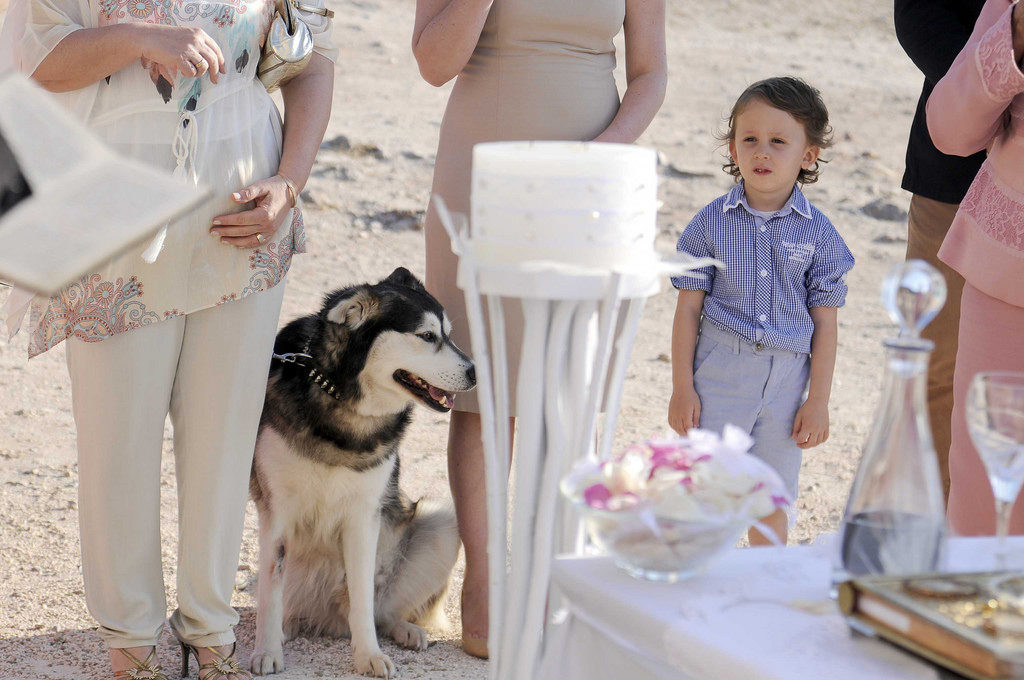
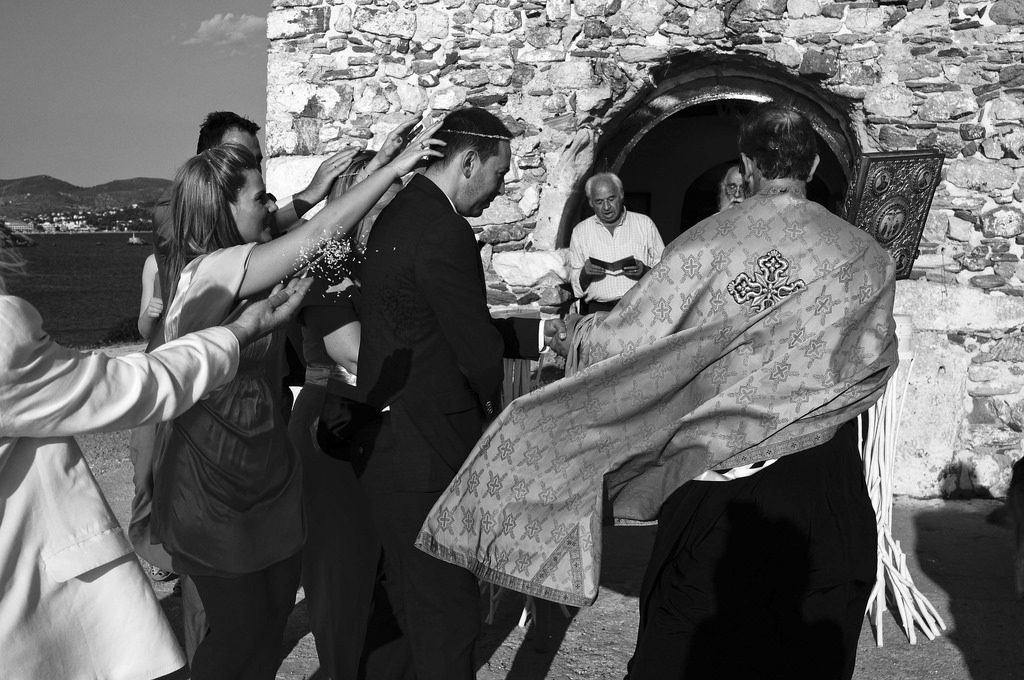
In a photographer less manifestly gripped by the facts of our fragile human being and ways in the world one might call some of her approaches formalist. It is certainly true that rhyme, echo, geometry, continuities and disruptions of line, shape and colour play a highly significant role in the structuring of her images but one of the driving forces of R’s work is that it constantly moves to dissolve any artificial divide between content and form. Yes, her eyes seek pattern; yes, this or that organising device might order an image but this never obscures our awareness of the facts, feelings and relationships portrayed or implicit there. Also—we humans are formalists, aren’t we? We’re pattern seekers. We play. Were you never fascinated as a child by mirrors, by the world turned upside down by hanging from your legs or by the cropping or heightening, or focus) achieved by looking through the cracks in your fingers? Of course you were. As we grow we perceive the whole world through a complex dialectic of what is presented to our senses on the one hand and our burgeoning sorting and structuring principles on the other. We are of necessity creatures of content and form together and one surmises that this is what makes us creatures of art too.
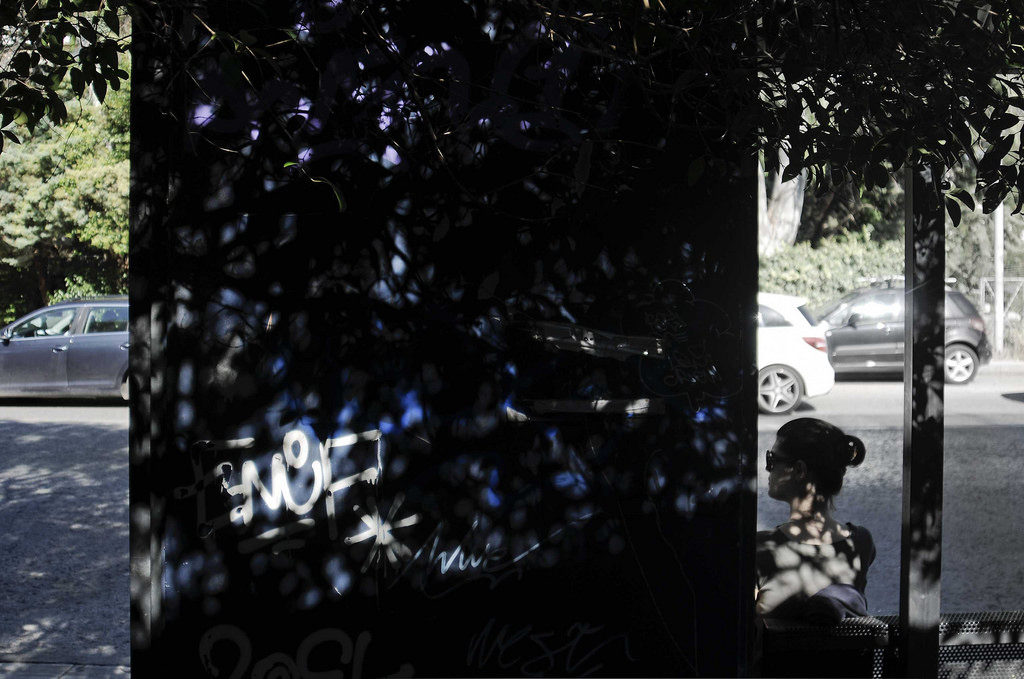
I’d been writing and thinking about this piece for a few months, on and off, and I’d got to a second or third draft when it hit me with a thud, a jolt, that hardly any of the recent images have titles.
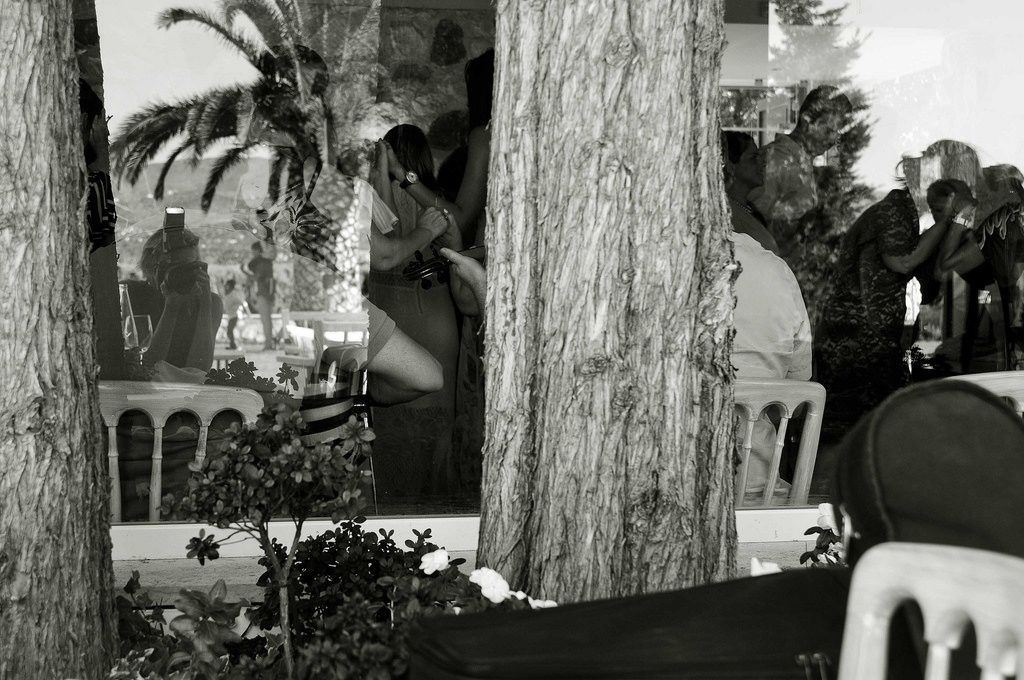
The fact had just sailed under my radar, curiously, since I’ve argued and will again, that insofar as we can talk about meaning in a photo (or any visual artwork) this possibility lies in a network of references and comparisons which ineluctably involves talk, writing or both. Language. Further, that visual art is best seen as something humans do (emphasis on both words) than as the usual set of isolable ‘in and of themselves’ objects (which isolation is a fiction, at best an analytical convenience). And then it struck me ( I was being struck a lot that day) that there is something about these images that fights back against language—they’re often cross genre and resist categorisation and there’s a sense in which the easiest approach to what’s in them is simply to list it, and finally to say that this image had these things in it under this kind of light from that angle but, of course, this is far from satisfactory and at root there is something far transcending taxonomy or description going on. But –dammit! –I can’t help feeling it is as if the images (placed as they are in the sequence formed by Flickr) are calling out, hailing each other. I don’t know why, but forced rhubarb, a most unlikely image, is the one which springs to mind and persists, as if the absence of the immediately adjacent language of a title somehow forces the set of glorious but hitherto mute images to invent speech.
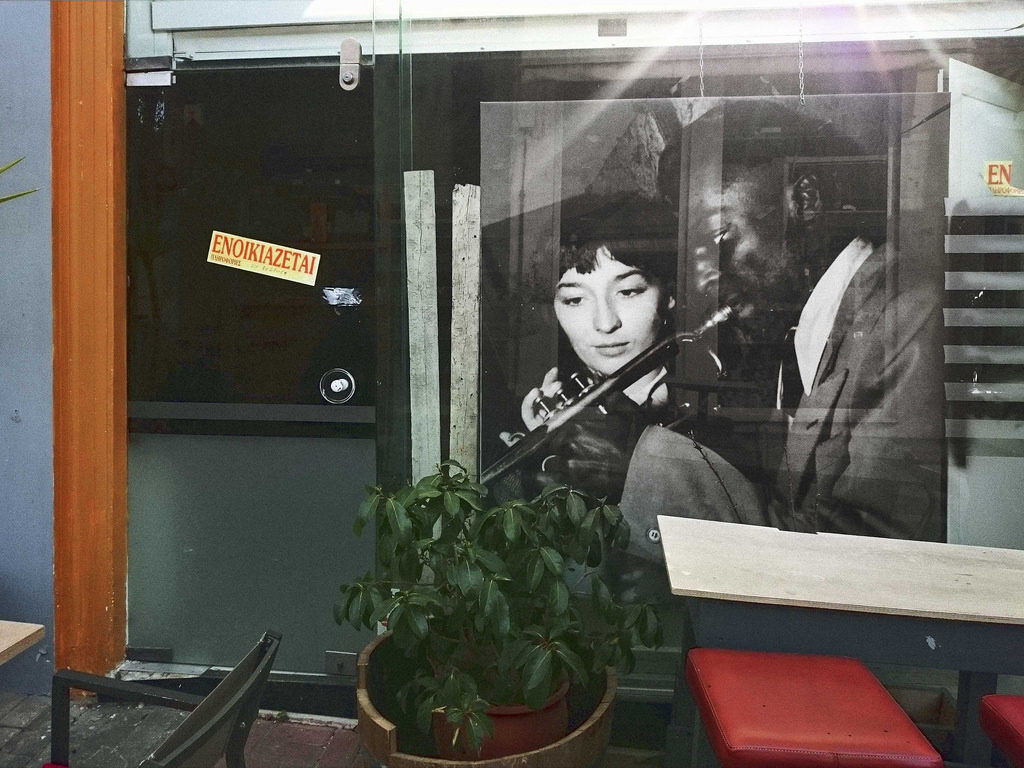
Anyone who has ever taken an un-posed image of a human being on a fast shutter speed will be cautious about ascribing emotions or characteristics to the subject on the basis of what is revealed. As in so many other ways, the very small, the very distant or unreachable, animal locomotion, the photograph reveals things beyond our normal ability to see or grasp them. One of these things is the curious plasticity of the human expression and how in our interactions we read this in sequence, in time, together with a host of other clues, aural and visual, to make sense of what is going on, to try to understand both what a person is doing and to surmise what they might be feeling . (Of course the opposite of this, the posed image, brings its own problems too.)
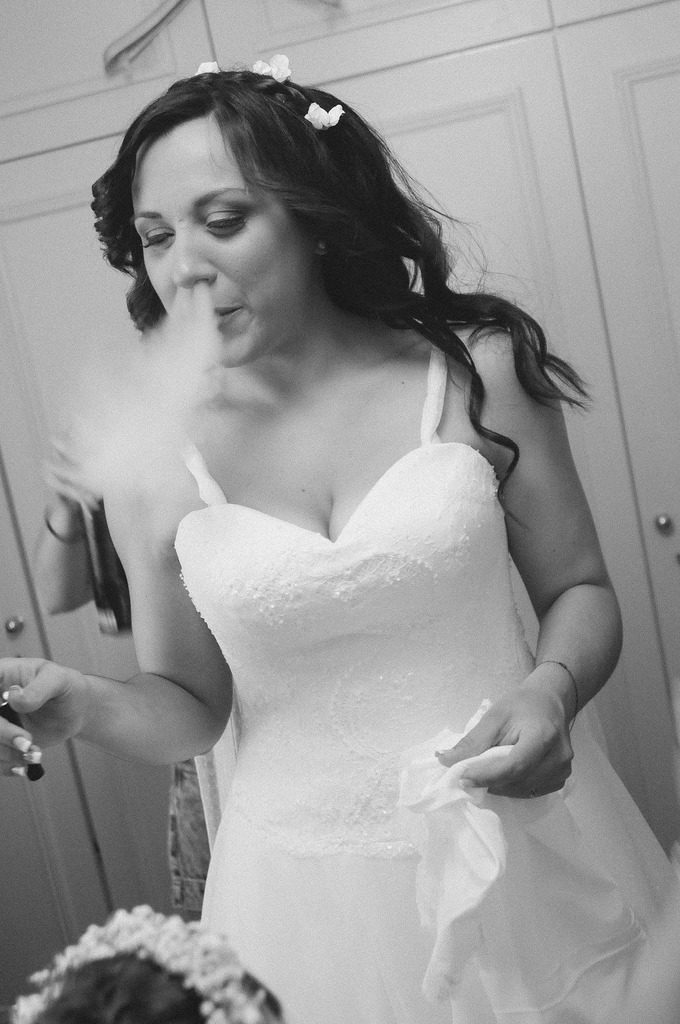
When we think hard and soberly we cannot but be convinced that the photograph alone, an impossibly small fragment of time, does not allow us enough evidence, that it is somehow unanchored in the world.
And yet, the desire to draw conclusions, to make comment, is certainly strong in us and each photographic image of a person, especially the striking and affecting ones, comes with a very strong sense that we are able to do so.
What can we actually say about the still photographic portrait, both in general and in particular cases?
One thing we might say is that the single image’s apparently complete account of a human being, based upon a fleeting expression (and perhaps the fleeting expressions in response of others and maybe also the presence of contextualising objects or other clues) suggests at best, a class of possibilities. This single image evokes a range of other possible images and moments in the world at least one of which must correspond to our strong intuitions about it. So even if we were able to establish the facts of the matter in this particular case and it made a lie of our emotional response , nevertheless that response represents a truth and somewhere, perhaps quite often, in the world, situations occur, have occurred, will occur, which correspond to this truth.
And it seems to me that it is this instinct for general human truth, allied to the particularity of light, line, composition, of other things depicted, which manifests in the eye-and-heart-catching-ness of the resulting final image.

A strong way of putting it would be that any portrait is just as much a work of fiction as a novel but that as we would not wish to deny something called ‘truth’ in the novel ( you might—I see no point to the thing otherwise) in the portrait we work our way back to truth.
And at least for me it is the photographer’s—and here, now ‘the photographer’s’ means R’s—capacity for empathy, for narrative, for understanding of the world and the wonder and the oddness of its inhabitants that makes her such a good portraitist (and let’s not forget, too, simply having done the thing a lot —this is often underrated nowadays.)
Do I know whether the Orthodox priest at the wedding table was a kind man? No. I don’t. I cannot. Is kindness manifest in the photo, is the possibility of kindness in the world reasonably asserted in it? Do I know more about kindness thereby? Absolutely.
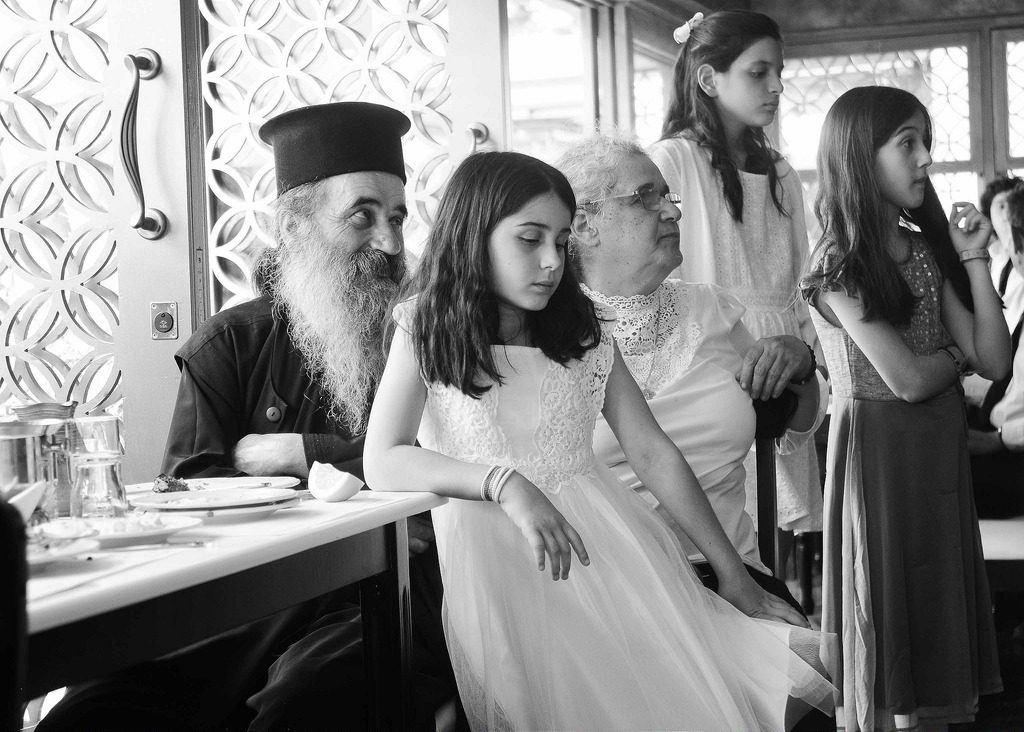
There’s a black and white image, taken, I think, at the place where her teenage sons practice their footballing skills which feels like a short story or perhaps a collection of short stories, each cued by the various human presences which form at one and the same time a large (in how they capture our attention) and a small (in how much actual area of the image they occupy) part of the entire image.
It also has a most clearly defined geometry—three strips, the topmost being the practice field itself, the middle appearing to be a road like depression running between the photographer and this field and the lowest a pavement of some sort on the other side of that ‘road’. The almost bizarrely long evening shadows of R and a companion (and the horizontal distance between shadows is nicely ambiguous on the exact relationship between those shadowed) stretch forward into the image. The vertical grid adjacent to them, with a gap in the centre picked out in shadow too, suggests they are standing at a pedestrian gate to the place. I imagine the figure at the viewer’s right is R as the arms appear to be raised in a photo taking action.
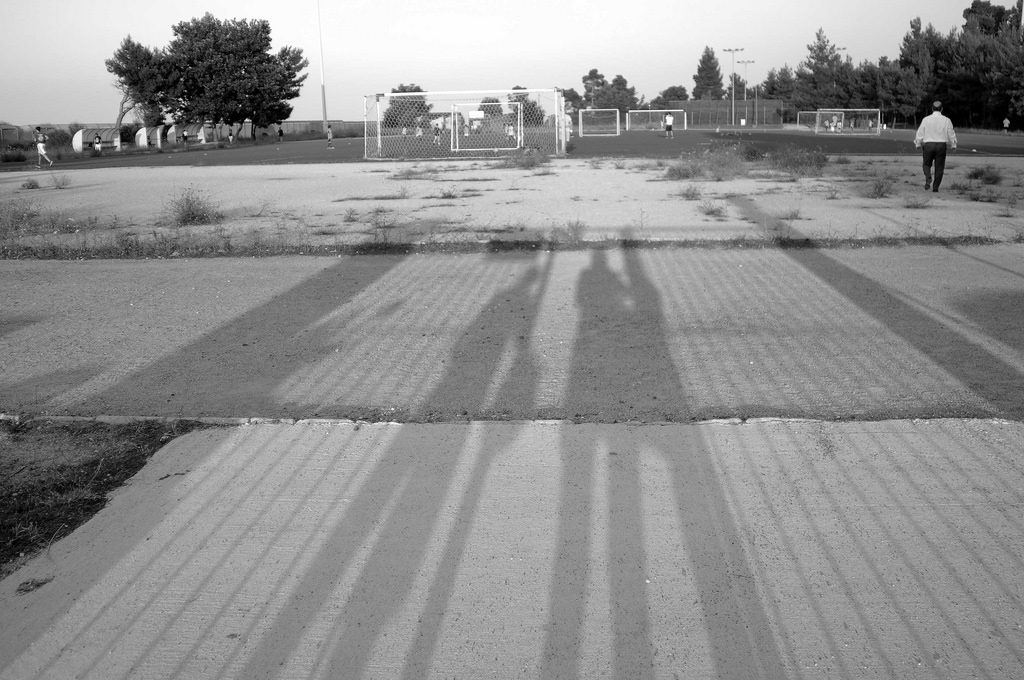
(The image thumbs its nose at genre—it is oblique self-portrait, landscape, social history, portrait and exploration of geometry and structure all at the same time.)
Shadows aside, the figures which catch my eye (what about you, so much to choose from or are you constrained in a similar way to me by something in the way the image is structured?) are the short stocky man in motion, walking away from us at the image’s far right top strip foreground. There’s a delicious swagger and confident openness about him.
Has he passed through the gate where R stands? Did he greet her?
The second key (perhaps because nearest?) figure is the young man, top strip, viewer’s far left, again in movement, this time almost certainly certainly sports related. Is he pursuing a stray ball? Running to greet a friend? Engaged in some sort of running warm up/exercise? As we strain to see, our relationship to the image’s scale shifts and we begin to realise just how many other figures he opens up to us—there are at least six either standing or seated in those little sheds at the field’s side between him and the left edge of the nearest goal net—each an enigma of a small but definite kind—and when we move rightwards from them we realise (and we have to move closer in, look differently, at the image to see this) just how many people there are in some sort of action here. As we move out again we are stuck by the contrast between the contemplative calm of the giant shadows and the anthill busyness of the young men. And here’s another thing. This is such a male photo. (With the exception of the photographer and I think it’s only because I know she is female that I read her as such. Then even as I write this I notice the slight head-cocked-to-one-side quality of aficionado-like attention in the head of the left shadow—and why do I think that might clue maleness? What does that say about me?) Oh! Layers and layers of fact, of presence, of things to enumerate and puzzle over. So much! And this before we take the thing as a totality—geometry, inhabitants, shadows, activity, motivation, time of day, distant trees, weeds and barren ground, a sky whose colour we can only guess from the fact we know there is evening sun. And that totality is the hardest thing to compass in any way other than an intake of breath or shiver down the spine. Enumerating the contents helps (although it’s not essential to the immediate affective apprehension of the whole—that just happens) but it’s the inexplicable (not a value judgement—literally inexplicable—simply, ‘This is what R did’) decision to frame those contents in that way—the bit of the process which defies words—that makes this and so many other pieces by her so powerful.
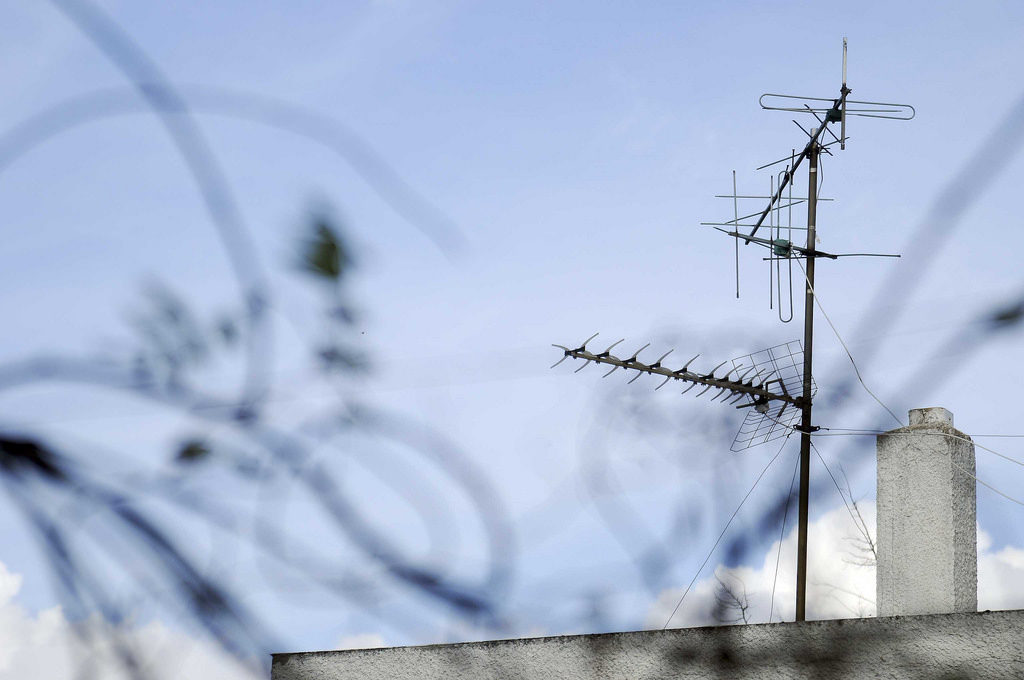
5.
A ravenous eye.
She has a ravenous eye, constantly tracking the scene in front of her and hungry for detail. This hunger does not distinguish between content and form. Whatever is human, whatever stirs affect or curiosity—whether pattern, rhyme or echo, or ethics, or suggested human warmth or frailty, this is swallowed up and processed by heart and mind in turn
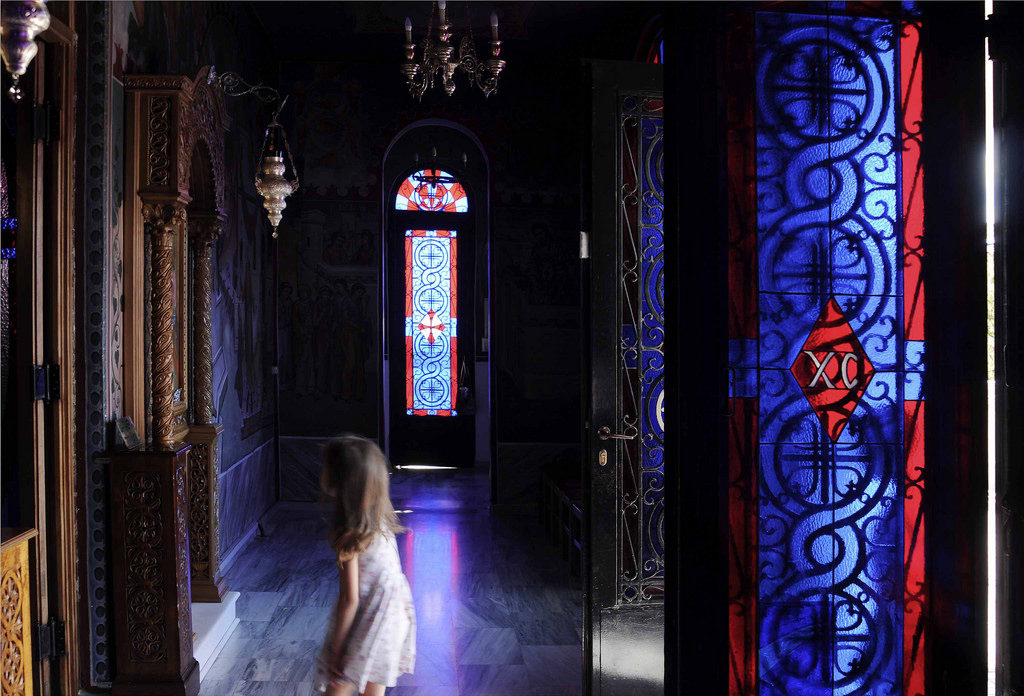
The resulting images bear the strong feel of certain, almost objective, structuring principles—that following of object or creature within a scene, the use of rhyme and echo. Two further categories are geometry and colour (and nothing here is pure, there are no essences, sometimes blocks of colour impose an extra, parallel geometry upon a scene whose first order sense—whether it be human beings in action or traces of interpretable human activity; buildings, signs, the street —apparently lies elsewhere.) The key thing about all these structuring principles is that they are found, excavated, discovered, seen—not made. They happen in parallel with, arise out of the actions and feelings of, human beings in this world, the only one we have.
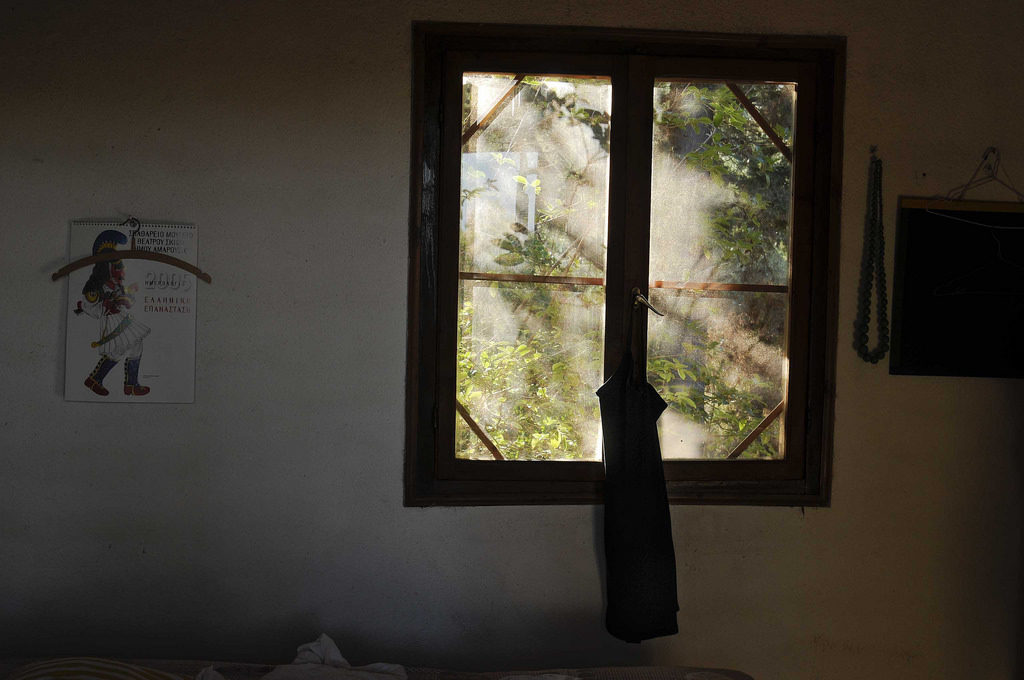
Because she is someone who has lived, fully, in that world, for a fair time, because her hunger extends beyond the visual (she always has a book on the go and the range of these is impressive), because she has a number of languages and is at home in at least three cultures, she makes images which are connected and re-connected by hundreds of threads to things we ourselves might have read and thought or experienced and talked about. Further, it is impossible to imagine that the fact she is a woman living in a country not of her birth, where she has learned a different script, different ways of talking and being, where she works in part as an image maker for hire and constantly both connects and holds separate that work for pay from own ‘own’ work, at the same time as raising children by herself, that these facts are not also somehow foundational.
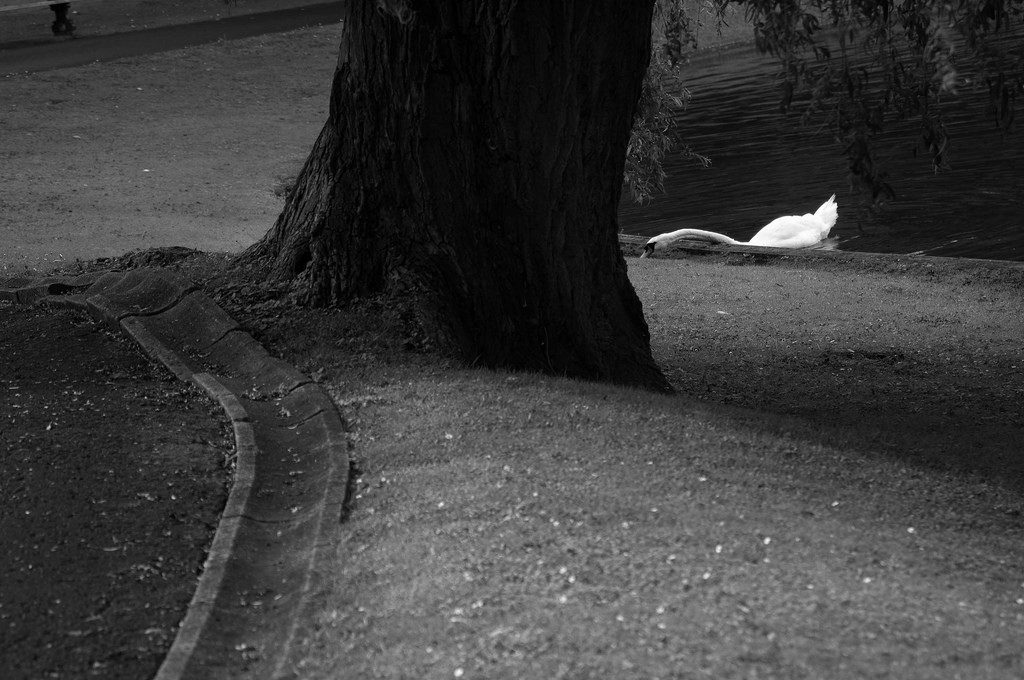
For a long time I have struggled with how to attach the word meaning to image. It is too easily and glibly used. An image never ‘means’ a single thing (unless it is the poorest of images and even then the human capacity for/delight in ambiguity sets to work to disrupt this) What is evident in Rudolph’s work is networks of evoked meaning, memories, feelings.
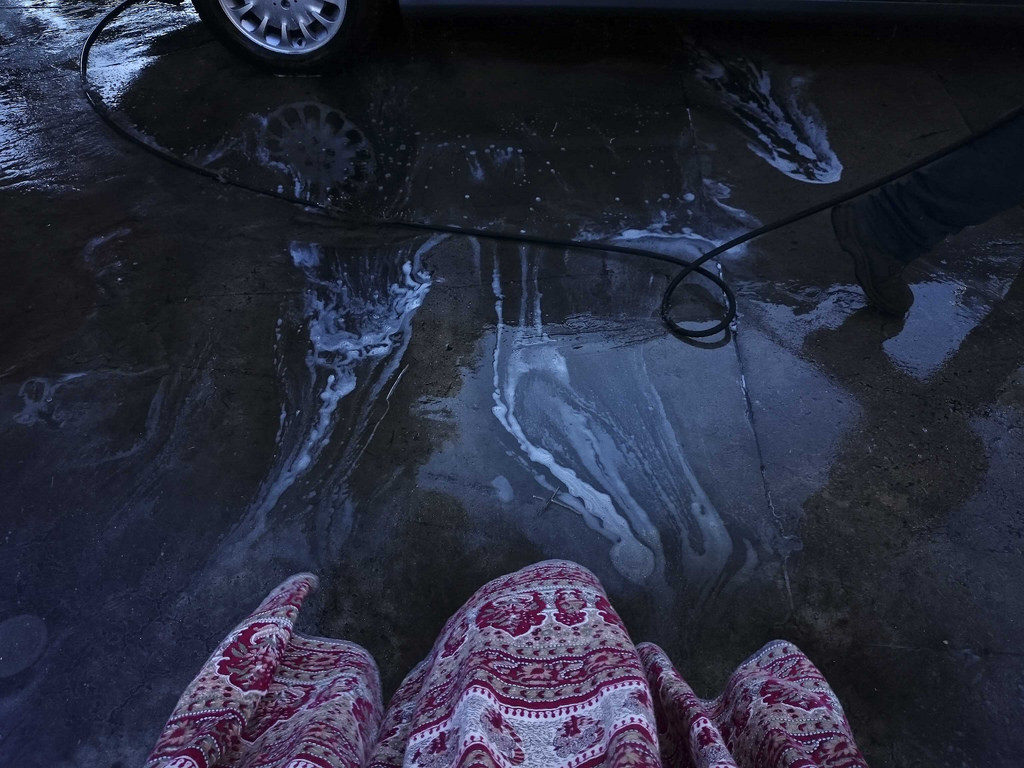
Her way of being in the world, this following her eye and nose, means that there is a kind of metonymy purged of any attempt at system—here is a dog or child or chair or window. Here are the things which necessarily were near it at a moment in time and this is how they were disposed. There was reason and there was randomness. Parts of the disposition were beautiful. (What do I mean by beautiful? They move me, they fill me with a joy that cannot be reduced to words though it perhaps can be limned by various combinations of words, combinations potentially infinite which always nearly but not completely fail.) Parts of the disposition were stark or threatening or at least worrisome. The bringing together of all these parts—worry, beauty, pattern, action—into an image framed, bounded, lit, by the laws of the heart and the laws of the intellect now pulling one way, now the other. The work about the world is itself part of the world. We are not alone. No person is an island. We can read each other’s thoughts. We can feel each other’s feelings.
The words and the image and human heart and human history dance ever outwards and outwards. What does an artist do but always start to write the whole history of humanity in the world?
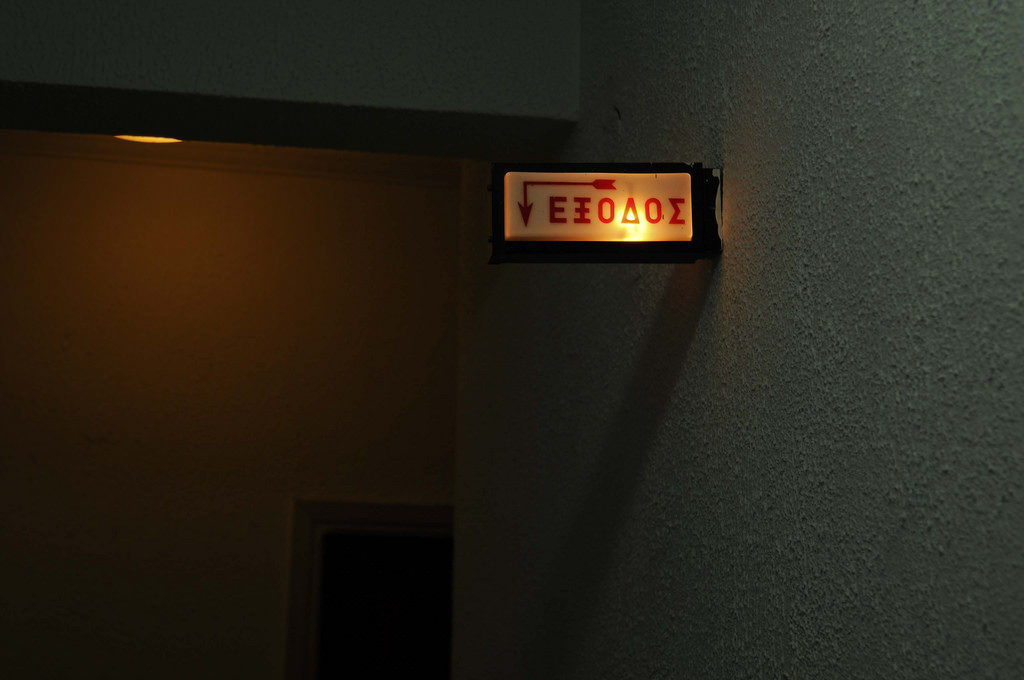
In the second of three articles about the Web 2.0 photosharing service Flickr (the first is here), I continue to make a case for the quiet but profound innovations created by the sheer scale and ease of use, of these services – something which enables self defining artist, outsider artist, hobbyist & people who would run a mile from being called an artist to share and be mutually influenced by each others work. Here I offer some notes on the beautiful, funny and humane photography of London art teacher Joseph Cartwright, who operates under the Flickr name Noitsawasp.
Very few humans directly in these images but everywhere traces, evidence of human activity. Not cold. Full of humour.
Patterns of human activity, some accidental but capable of being invested with new meaning. Some straightforwardly meaningful, interpretable. Evidence of events and activities.
Always formally engaging.
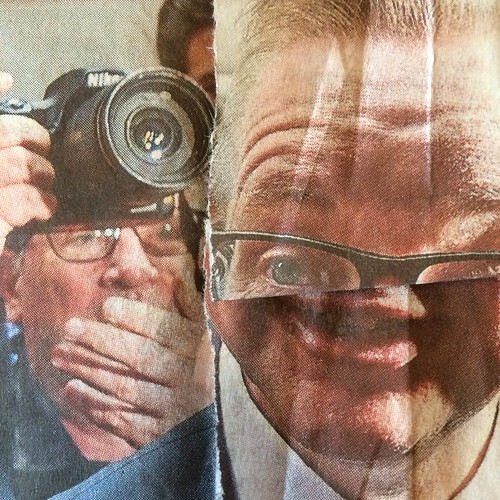
A map of a world. A map of our world. A map of the world of work, of most of us, of the 99%.
Impossible to imagine these images made on streets of a town where less than 50 languages were spoken.
What we see when we look at these is what we see when we look at art.
An invitation to narrative.
Patterns on the one hand // traces of the wake that humans leave behind them in the world.
One of those humans is Joseph C––sometimes the images are records of his interventions in the world of images––those image fold-overs or blends. Sometimes the photos are a record of him as performer, actor, in the world ( but after he has left the stage). Sometimes they seem to place us directly behind his eyes.
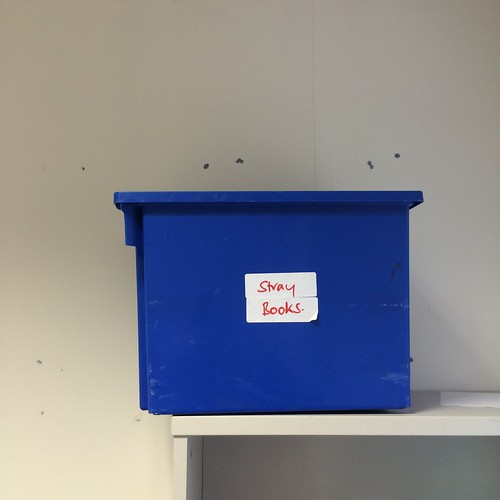
I think he looks quizzically at the world. Do you know him––does he look quizzically at the world?
You imagine his eyes darting around––down, to the side, up occasionally, lighting on something, some congruence of objects, pausing to decide whether to make an image…(brows knotted, a sense of pressure, the need to seize the moment…)
look at this; see through this; look into that; make that out
grids; grids; patches of light; a dictionary of cowboy terms
People nail nails, people mend things, people bend things, people break things, people clean, people wash clothes, people read, people admonish, people alert, people have funny feelings––goose bumps, shivers or feelings it’s hard to explain somehow.
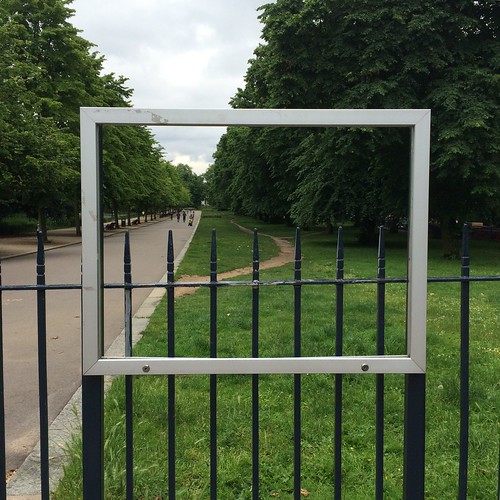
I saw a pattern! It was a message to me! It was a message to you. It made me feel…oh…I can’t say what…
This empty table here; those empty chairs there
The café/condiment photos––a series––eating––so basic––and we always remember that but we also think––‘we know this kind of café too’, ‘we go here on these occasions’––and we wonder what kind of a person this serial café goer is, is this an important routine in his life, does it define him amongst others, his friends, colleagues, what does he eat, are the condiments incidental or fundamental to his café visits, does he keep his distance from the condiments, use them with discretion, does he go to the café now only or mainly for his mission to image the condiments or do his meals and his art dovetail nicely, conveniently, pleasantly here. Do his companions laugh when he takes today’s photo? Or does he eat alone?
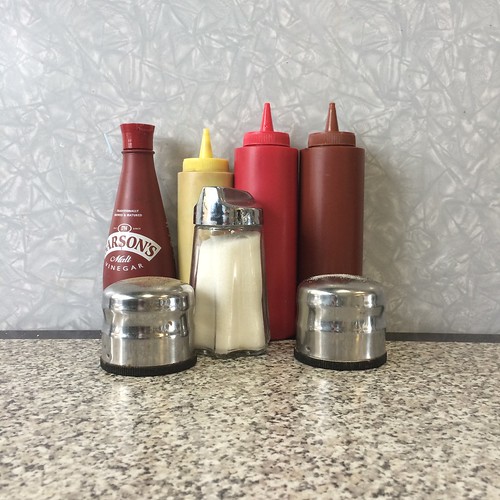
Cables, pipes, tangles––runes, ciphers, hieroglyphs.
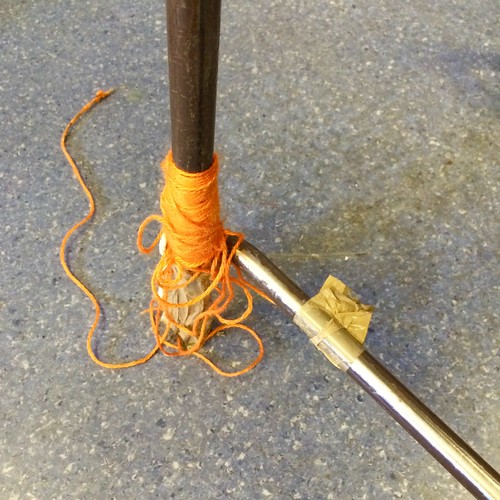
The morning was sunny. It rained. The afternoon was still warm but muggy. There was a rainbow. The sky was blue. The fence was a different blue.
Shadows, folds, stripes, other repetitive patterns. Some there, pre-intended, functional. Some found, loaned, in the process of making the photo.
Objects that are (or have been) useful or functional removed from or seen out of their usual context. (Sometimes by human agency––dumped, temporarily abandoned, or simply cropped)

Estrangement––making us see the world anew // making us remember our world anew.
Found patterns, found juxtapositions.
A lively eye and a lively mind.
Joy in colour. Grace in handling, in apportioning that colour. It’s like he finds the best tidbits and, smiling, hands them to us.
It isn’t abstracting from the world // the function is often still evident so it’s like layer upon layer of meaning and affect and confusion // the original function or action…the strange pattern it makes… its removal from its usual context.
These images lend us Joseph C’s eyes. These images lend us another human’s mind and sensibility.
When you are a child and you’re walking along by the side of a grown-up and they have important things to do or say and so you are free to look around and feel and think and wonder and also you are half their height or less so you have both the utter freedom to look where you will and you lack preconceptions about what it is you see signifies or how it ought to make you feel and on top of that you see it from an angle that will never again be natural to you without a degree of contortion. And you are become magically a kind of still, observing, feeling centre of the world.
Joseph C gives us back some of that.
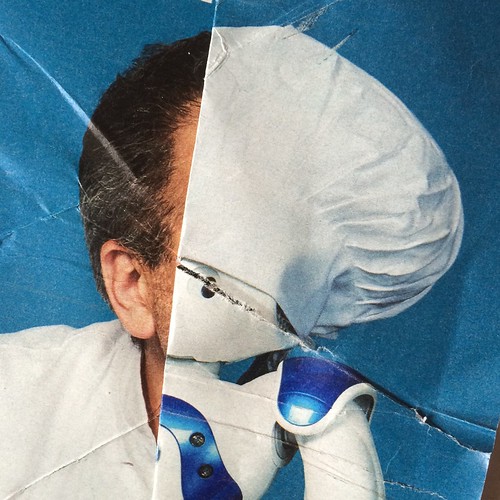
“I-love-you: the figure refers not to the declaration of love,
to the avowal,
but to the repeated utterance of the love cry.”
Roland Barthes, The Lover’s Discourse. Fragments, 1977.
Designed and published online on October 14th 2004[1], restored for The Wrong (Again) on November 1st 2015, the website I Love You by French artist Jacques Perconte[2] is not only a wonderful achievement of his research on image files visualization through the Internet, but also a fundamental piece of artwork for three reasons: first, it crystallizes a history of audiovisual technologies in the web age; next, it allows the analysis of his singular inventions on plasticity which are shaped by the offensive processes and techniques Perconte has developed until 2015; finally, it makes explicit the artist’s constant will to put the body to the test of digital technologies (in this case the partner’s body) and to literally inject life (each and every thought, interest, feeling, emotion, excitement, and desire aroused in him by the beloved body).
Two events in 2003 gave birth to this piece: a publication proposal from French publisher Didier Vergnaud of a book with the digital photographs of bodies he had been taking tirelessly; and his romantic encounter with the woman who would become his partner, muse and model, Isabelle Silvagnoli. I Love You merges two stories, two passions. The one with Isabelle blooms in May 2003[3]; at this time, Perconte has already an extensive experience of digital technologies that he had developed since 1995[4].
At the Bordeaux University, when Perconte notices that a computer is connected to the rest of world, he becomes aware of the technical and aesthetic issues of the digital network, issues largely ignored at this time. His quick mastering of how the web operates leads to a decisive work on “the digital bodies”: three image generator websites (ncorps) and four films made by re-filming multiple loops of these animated pictures. This series denotes that Perconte has assimilated four essential dimensions of the digital.
First, he notes the image exists primarily in the state of a compressed digital signal that needs to be displayed; the signal recorded and stored as a file is a model, shaped by algorithms; its visualizations change only according to the codecs and the supports. Next, he distinguishes the human dimension of the web: the bodies of the users surfing the Internet on their computers and interlinking one another.
Then, the material dimension: the computers interconnected by an abundance of servers all around the world which produces a random digital time; indeed Perconte noticed the connection time to the hosting server of his websites was unpredictable since the answering time fluctuated according to the Internet traffic density, the connection’s and the browser’s qualities, and the computer’s performance executing the query.
So he notices the fantastic system failures: “when the first JPEGs popped up on websites, it wasn’t unusual for a picture to be only partially displayed. Sometimes, this happened to produce strange distortions in the image. (…) Every now and then, the image would totally turn into an abstract composition with amazing colors.”[5] Consequently, these fluctuations of display reveal a prodigiously fertile field of investigation: recoding the visualization. Finally, the web can be defined by the coexistence of places, bodies, machines, protocols and programs interacting in complex ways as an evolving ecosystem. Thus, a device aimed at transforming models could be designed (model meaning both the person the artist reproduces with forms and images and the coded reduction), as GIF or JPEG sequences animated on a website. Since the parameters involved in the visualization of these sequences are renewed at each connection, Perconte knows these metamorphosis will be unlimited and give birth to n bodies [corps]). This research allowed Perconte to establish, by 1996, a stable platform aimed at recoding the visualization within the web to ultimately break the limitations of the model’s code into which the digital signal is reduced.

As he undertakes assembling photographs of Isabelle for the book project (38 degrés), this experience of the web will come back to him. The collection of several thousands digital pictures springs from the extensive exploration of the beloved body’s patterns and the obtained signals he looped (he retakes the displayed pictures several times), in an attempt to test the representation of love. The problem is twofold. On the one hand, this collection can only be unlimited since the observation is inexhaustible as he puts it: “when I think about her body, I dream of landscapes so large that one gets lost completely, there is so much to recognize, kilometers of skin where warmth rules, a soft, almost empty desert. Beauty, immensity where every vibration of light pushes the colors to reveal themselves in new ways. The variations (…) are endless.”[6] Furthermore, despite experimental photography techniques, he quickly reaches the limits of how much an image is capable of expressing absolute love. In order to find and visualize this love present within these files, Perconte selects and ranks hundreds of these images in a database and places them in an ecosystem on the web.
Perconte developed a server-side program by writing an open source application in PHP, the love writing program[7], in order to quantify the love present in the source code of these digital images displayed on the web. Love being unquantifiable by definition, the artist must add an arbitrary but rigorous calculation. This quantification is performed by the application triggered when a user clicks on one of the images of the collection: it calculates a specific variable by taking into account all the physical parameters of the connection but also the mathematical constants of proportions and universal harmony – ∏ and F (the golden section); then the application opens the image file, transforms it as a hexadecimal code and substitutes every occurrence of the sought value by the phrase “I Love You,” thus changing the architecture of the code describing the image. The browser requested to visualize the image compiles the modified code, but can only display it partially, at the cost of radical visual transformations, such as reconfigurations pixel structures, the emergence of new colors resulting in the reinterpretation of original motifs or subjects; the greater the amount of pure love, the more intense the abstraction. The motifs of the beloved body can mingle or merge entirely with the figuration of love. The browser is sometimes unable to visualize the image resulting in the appearance of a broken icon with a quote from Roland Barthes: “To try to write love is to confront the muck of language: that region of hysteria where language is both too much and too little, excessive (…) and impoverished (…).”[8]The broken icon evokes a digital iconoclasm, but furthermore signifies the limitations of visualization protocols that have been overtaken by an overflow inexpressible love. This substitution in the image source code of a value by the literal writing of love, raises the Perconte’s program to a “loveware.”[9]
Not only has Perconte given life to this website, but he has been maintaining it for the eleven years he has been sharing his life with his partner. First and foremost, he constantly upgrades it. Indeed, he programmed on February 14th 2005 an “I Love You Collection” of all the “I Love You’s” which will be written in the images’ source code; from this description, the “Love Counter” determines the number of “I Love You’s” and their transposition in bytes: “This is a concrete and scientific way to know as precisely as possible how much love is streamed online, and more importantly how much love is contained in this work. Every time a picture is displayed and the code modified by love messages, the counter is updated. The more time goes by, the more love grows.”[10] Thus, the users themselves, without suspecting it, testify to the history of this Perconte’s love for his partner, write this love, perpetuate and amplify it. Donating his images to the network, leaving it to others to speak for him, the artist is no longer the excessive delirious lover (wonderfully described by Barthes[11]), but one who loves. Then, the artist updates his website on a regular basis.
For each exhibition he replaces the image collection and operates small technical changes in order to avoid falling behind on the developments of the web. Furthermore, he designed a photographic exhibition of this work started in 2003, It’s All About Love, from January 17th to April 17th 2008 in Pessac, where he gives to the public a synthesis and extension of the project, in the form of prints and animations on iPods[12]. Finally, he undertakes a complete restoration of the website in 2015. Indeed, I Love You has suffered from a rapid disruption of the web and the visualized pictures often began to show large gray patches. The invitation from The Wrong gave him the opportunity to get back to this core piece. The solution – consisting in placing the website in its original technological context, that is to say, on a server with the same configurations as in 2004 – was met with refusal from the web hosting providers. This is how he decided to work with one of his students of Chalon-sur-Saône, Garam Choi, a true code virtuoso, in order to rethink the programming of the website according to a large principle which governs web in recent years.
From the beginning of the web until the posting of I Love You, applications were executed by servers. However, with the exponential increase in web traffic, servers quickly became overloaded; moreover, computers have seen their computing power and storage soar while other programming languages, like JavaScript, gained importance. Thus, the logic that governed web-programming moved applications to the client-side. Choi and Perconte have therefore developed identically, from the original program in PHP, an application written in JavaScript so that it could be interpreted on the client-side, while maintaining the database on a server. The issue at stake was to create a dialogue between the server and the client-side application, especially to quantify the number of “I Love You’s” and write it into the database. Indeed, server specifications entail technological obstacles as soon as the instructions are not in compliance with the protocol. But the artist was quickly able to find a way to instruct the program to circumvent the prohibitions. Indeed, not only does he operates the substitution technique to modify the images source codes, but uses it as a trick to fool the server. The idea is to do it as if the client were loading an image from the server to display it; but the called address executes instead a script, in other words, instead of the image URL, the number of “I Love You’s” is shown.
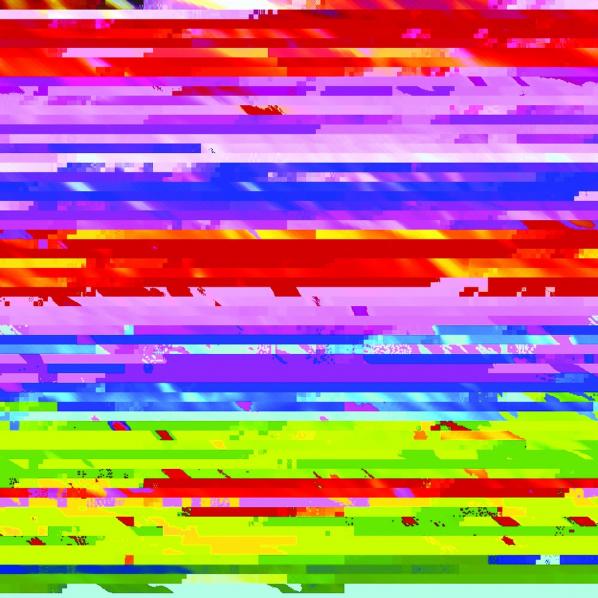
The website restoration therefore takes hold of the website’s programming in the 2010’s, but reinvents it with ingenuity. It also alerts the Internet user on how some multinationals IT companies (Apple, Google) consider the universality of the net: Chrome hinders some images display, while Safari denies their visualization. Also, in the latter case, Perconte and Choi have provided the following message to the attention of the user: “Safari is not ready for love. It’s still blind.” On the contrary, the Firefox browser, developed by a global open-source community, allows optimal operation of I Love You at the exact replica of the first 2004 version. Indeed, Mozilla defends a free Internet that would be “a global public resource that must remain open and accessible” in which “everyone should be able to shape the Internet and their own experiences on the Internet.”[13] That is why the growing love of I Love You does not only symbolize the artist in his couple, but elevates itself to a principle of universal union and intimate communion through the web: a set of values that affirm a convivial conception of society resisting consumerist models imposed by technical industries, and taking the power of the Web back in the hands of all users.
I Love You is therefore crucial for the Internet user, the historian, the media theorist, the film analyst, the archivist and the curator of the twenty-first century. It invents a thought of the program as a plasticity fertilization tool through digital visualization technologies understood as open and unstable. It successfully manages to offer bright and virtuoso processes and techniques of recoding, exciting insights on the operation of some display supports and devices, along with their history and unrelenting criticism, and the refined and infinite visual writing of the story of a man in love through a limitless range of radical visual forms generating a pure aesthetic delight. It is an artwork that lives and grows thanks to the Internet users as a digital lining of a relationship blossoming in the world, and which, since it has adapted and transformed to the changing technological environment, becomes the figurehead of a libertarian conception of the Internet and digital technologies in general.
Warmest thanks to Nicole Brenez, Gaëlle Cintré, Kamilia Kard,
Filippo Lorenzin, Zachary Parris,
Jacques Perconte and Isabelle Silvagnoli.
(In)exactitude in Science : http://inexactitudeinscience.com
and I Love You : http://iloveyou.38degres.net
Text is translated from the first french extended edition : http://www.debordements.fr/spip.php?article431
‘I love kitsch. I adore bad taste. I fall for the maladroit.‘ – Andrea Judit Tiringer
In a recent book ‘What Photography Is’ – and just what it is seems to be akin to the meaning of a word for Humpty Dumpty – “just what I choose it to mean – neither more nor less” – the critic and theorist James Elkins savagely lays into the users of the photography sharing site Flickr. There’s a page or so of magisterial denunciation delivered in a scornful tone not unlike Humpty Dumpty’s: “Nothing is more amazing than Flickr for the first half hour, then nothing is more tedious” and “…each group puts its favoured technology to the most kitschy imaginable uses”.
1.

It’s not that Elkins hasn’t hit on something – all the sins he bemoans, and more, certainly exist on Flickr but his is a superficial, lazy and tendentious view which evinces a shocking lack of curiosity and imagination for one so exalted in art academia. (Indeed so incensed did Elkins’s tirade make me that I started a Flickr group entitled Bollocks to James Elkins: https://www.flickr.com/groups/bollocks_to_james_elkins/rules/ please consider joining if you’re active on Flickr.)
Flickr gets lambasted too, from the opposite perspective to Elkins, by the proponents of a kind of “bottom up”, “anti-elitist”, account of art, by those who dislike its corporate ownership and by those, too, who believe that one should build such communities with pure free and open source software. To be fair to them there is here, too, much to agree with; Yahoo, Flickr’s current owners, are clearly more interested in maximising advertising income than the welfare of their users.
And yet, and yet… a little looking, a little thought and, hardest of all it seems, a little intellectual humility reveal – perhaps only the embryonic stage of – something rather marvellous too. The sheer scale of the network of users (which one must point out here could only be a utopian hope for an alternative network, at least under the current social and economic system), the fact that it is impossible that the art world as it currently exists can (or might want to) present to us every piece (or even a small percentage) of work worthy of our attention and, further, that there are many people for whom the impetus to make work is a stronger imperative than getting on in life, or becoming celebrities or making money – akin to Marx’s “Milton [who] produced Paradise Lost in the way that a silkworm produces silk, as the expression of his own nature” – means that careful sifting reveals artists every bit as worthy of our attention as those who please the art-world gatekeepers.
I’ve found hanging out on Flickr enormously nourishing both in terms of intelligent feedback on my own work but also in terms of the diversity of interesting and engaging work by others, some of whom even employ the “favoured technologies” – which largely seems to mean software manipulation – Elkins finds so risible, but in such a way that any honest accounting would find far from such.
It is true that one is tempted on occasion to conceptualise some of this work in terms of “outsiderdom” and this can be a helpful starting point; but there is a quantity/quality dialectic at work in the sheer size of the Flickr database and in the dialogues between the highly focussed outsider, the odd art world figure who doesn’t fear to rub shoulders with those not in the charmed circle, the family snapshot taker and even, though admittedly rarely, the amateur photographer who takes “well-made” photos but doesn’t forget to make them interesting too. There is a wider point contra Elkins here which can be expressed succinctly as – no form, no technique is in and of itself ruled out from the process of making art. Indeed the greatest artists have often taken the lowly, despised and out of fashion and given it a magic twist to create previously undreamed of possibilities.
I venture to suggest that the beginnings of something qualitatively new are here stirring.
That’s a long preamble to some showing, rather than telling. I want to look at a single and in my view very interesting participant on Flickr. First to introduce her work and then talk to her about what it means to her to make and post it.
2.

nem sáℜa (Hungarian – ‘not Sara’ – the odd typography for the ‘R’ is a personal quirk and not a language feature ) is the name under which Andrea Judit Tiringer posts work to Flickr. Her body of work is at the same time highly consistent and extraordinarily varied. There are, at the time of writing, 252 images on her Flickr stream – all of them are 444 pixel squares (although I gather she retains larger versions offline). Of the images the vast majority feature a face or figure and this is usually Tiringer herself, a strikingly good-looking but usually (only three or four of the self portraits have smiles) melancholy presence. The focus of the images is variable and the colours are largely muted and pastel. A number of the images feature text, mostly in Hungarian (and occasionally other eastern and central European languages and once or twice even English) and most of them are clearly the product of some process of collaging. What is striking about these images is how sophisticated the use of the space is – there is no sense whatsoever of any “algorithmic” approach to the making of these works – no recipe – each one feels thought through from the beginning and one can linger on each and find new and interesting content (by which I also mean marks, variations of focus or colour, absences, difficult to decipher sections) and relationships within it.

Some are funny (or perhaps lugubrious is a better word) with the kind of tinder dry poker faced humour I particularly associate with Eastern Europe (Nikolai Gogol… Jaroslav Hašek… István Örkény) and which seems to have further fermented as a regional characteristic during the period 1945 to 89. A number of the images either appear to be entirely drawn from albums of snapshots (maybe family, I’m not sure) or to feature components drawn from this kind of source.
A number of the images have drawings or written text added either by superimposition or in a separate space. Sometimes this takes the form of ink stamps or documents such as receipts or other official formats. Many images are divided into sections; sometimes of the same, repeated proportions, at others into something less structured. The sense of internal barriers marking off distinct sections is a strong one. These barriers are created in a number of ways – repetition, addition and the use of drawn or printed line.
The meaning of the texts, as much as I can make out the non-English ones, seems at least on the surface completely unrelated to the image content but, of course, the viewer naturally seeks such connections.

Many pieces employ “traditional” symbols of femininity – flowers, dolls, a killer dress sense. This also seems tied up with a summoning of the experience of growing up – we see a number of images of young girls. Again I’m unsure whether these are of a young Tiringer or simply found images. What does seem clear is that they carry some autobiographical charge. They are never twee (or if they do tread close, the surrounding work pulls them back from the brink and they become “about” tweeness – and if I can put it that way, the “whyness of tweeness” rather than exemplars of it). Equally the femininity cited above is certainly not inconsistent with strength and confidence. A number of the images allow us an intimacy which many self-portraitists would baulk at. Older women appear with relative frequency and are treated with tenderness and respect, as are images of daily household routines, of “women’s work”. Men appear in only two of the 252 images.
This image series is complex, subtle, sophisticated, mysterious and very beautiful. It is structured with a high level of intentionality by someone who is technically clearly completely in control of the visual language they are using but also open sudden dispatches from the unconscious. Whilst I’m always chary of ascribing “meaning” to works one can clearly delineate here a central set of concerns/hauntings/ pleasures/what-have-you which crop up repeatedly. Femininity, ageing and transition, female solidarity, day-dreaming and play, humour, storytelling, dressing-up (both the childish and the older sort) forming a kind of core around which other rarer, more peripheral themes appear and disperse.
This is not minor work.

3.
I interviewed Andrea Tiringer in English by e-mail over a couple of weeks in late August and early September 2014. Her responses appear largely in the order she sent them although I have interpolated some purely factual responses from an earlier exchange for clarity and I also corrected any (very few) errors of English usage. She checked the final interview text to ensure I had not altered the sense of any of her comments.
Could you tell us a bit about how you came to start making this very distinctive body of work and what you feel you are trying to accomplish with it?
I prefer to exist unrecorded. I take comfort in the temporary nature of things. I am always impatiently anticipating the new…. everything, I never want to hold the moment, yet somehow this photographic urge crawled into my life, without me taking notice.
The first step must have been years ago when I suddenly wanted to capture my grandma’s life. We had weekly sessions: her, me and my tape recorder. She was indecipherable. I tried to capture her essence. I needed her stories to be mine forever, figure out how to have a little ‘Róza mama’ transplanted into me. She expected me to be impossibly glamorous, the way she never could be. As far as she was concerned, that was my task. I was born at a time when girls could be scientists, astronauts, writers, but she did not want me to be a scientist, astronaut or writer, or only maybe as a side project to the grand life. She would look at my shoes and ask: were they expensive? The only acceptable response was: very.
Fast forward to about 2010 when for some reason I found myself chasing a nun on the street because I wanted to take her picture with my cell-phone. I have no idea why. I had no camera to my name, I had never before taken a photo on a whim. I caught up with her (she stopped to look at a shop window, my favourite kind of nun behaviour!) and at home I turned the poor thing, with the help of some online editing tool, into an unsightly shade of purple. I was pleased.
Some weeks later I threw a camera I found at home into my handbag, thinking, ‘Maybe I will run into something that I can take a picture of’. I saw a shabby garden through a ramshackle door. It was obvious right from the start that reality does not circumscribe me in any way.
I love kitsch. I adore bad taste. I fall for the maladroit.

So how did the very singular topics and imagery in the photos you post to Flickr came about? I’m particularly thinking of the repeated self portraiture which must be a feature of 90% of the pieces…
When I was a little girl I was convinced that just as we watch the people on TV someone somewhere is watching us, so we always have to show our best side. In my mind it worked like this: the interesting and good looking are on the telly, the rest on the radio. I would dress up to the nines and sing, because I figured if you did not have a good voice you only got to give the weather report,.
These auto-portraits are quickies. Passport photos, accessorized. Captures of what I am not but maybe could be. They are like a colourful puzzle. I never plan anything. (Actually I have planned to stop for about the last 100 images yet still I keep taking another one. I like them for a couple of days, even weeks sometimes, then forget about them, or they start to annoy me. I am a happy deleter.)

About a year ago I made an air freshener out of one. I adored that! I decided that if they are ever to materialize they will be just that: fake cherry scented tiny fake me’s dangling away in a cube shaped space and challenging visitors’ olfactory and visual endurance.
You say: “Captures of what I am not but maybe could be. They are like a colourful puzzle.”
Could you expand on both of these points? Could you say something about how the other content in any particular self portrait relates to the portrait itself and also what is happening in the pieces that don’t include a self portrait?
It’s extremely hard to describe a scheme as to how they are conceived. When I first started to create these images I haven’t taken a self-image for years. I did not even consider it, I captured what I liked, added my touch, altered them to the best of my abilities. I was getting familiar with the editing software through the process on my own, meaning there were many, many mishaps. Those were always welcome.
At some point the first auto-portrait must have happened, and of course I had all those traditional expectations: look good, appear interesting etc.
I started to think about scenes, but my goal was to create something that cannot be named, that is not easy to place, to find a category for. I avoided obvious symbols. No hearts, no crosses, no stars, nothing that could serve as a clue to the… who knows what?
When I choose the constituent elements, my decision is based only on the colour and geometry of each. This includes my attire and surroundings. For example, I look at the front of my blouse and it reminds me of ovaries; this leads me to a vintage anatomical model I printed the image of weeks ago, the colour of which somehow reminds me of a tiny burn I had on my skin at that time, so I took pictures of these and assembled an image from them..

Each has such individual stories, I never premeditate, it is such a quick process. As for the words, it amazes me the way sentences, taken out of their original context, suddenly stand bare: the absentminded cruelty in the prim cookbooks for proper ladies, the description of a slip-up from a madcap novel for teens that suddenly reads like major romantic poetry. I always photograph texts that catch my attention and if I find a loose connection I may add them to an image. Again, each one’s story is so unique, it’s hard to describe any rule or pattern.
I think there is no difference between the photos with me and the ones without me. I just haven’t found my place in each of them yet …
You’ve described quite lyrically and also humorously some of the personal sources and feelings behind the work. What I’d like you to do now is to talk us more clinically through the way, technically, that you set about making each image. Do you have, after so many, any set approach? What software do you use? How long does it take to make an image and do you make sketches or drafts before settling on the final version? Is there anything else about your approach you think is distinctive?
I use a point and shoot Nikon Coolpix, a simple, simple people-camera, I am not even sure of the exact make. I use GIMP to edit/composite.I have never made a sketch, I do not plan and plot. Something happens and I register that and this results in an image. I am presented with a pear and I casually place it beside me and notice it could belong to the pattern of the dress I am wearing. I look at items from a past exhibition at the medical museum in Budapest and as I catch sight of my reflection on the screen I perceive a concordance between me and the disfigured fetus in formaldehyde. If in those situations I can reach my camera I take a quick photo and it may become part of one of my squares. I try to avoid any set method, the only rule being the square shape.

I love taking photos of strangers. I love happening upon strangers that I want to take photos of. I love happening upon anything at all that I want to take photos of but I noticed that I got pickier over the years.
The found images come from everywhere and anywhere. Family photos, my huge box of vintage snapshots, movie stills, random Google Earth takes. My only rule regarding these is that I have to take a photo of them. No scans, no screen caps… This enables me to add my own mishaps, to “destroy” the originals with my technical shortcomings.
Of course there are schemes I could use. If you tell me to create a photo I will tell you to come back in half an hour and I’ll have it. To you it will look like the rest of them. But if I wait for my moment it can be in ten minutes or never (and I do not care, this way it is extremely personal, diary-like).
The reason I feel like stopping after each one is because their increasing number makes it a challenge to make new things, not to find myself in a rut.

So finally, given the fact that you post your work to Flickr I want to know how you view yourself? An artist? Someone with art as a hobby? An outsider artist? Some completely other category? And I want to ask too, if you had the chance to show this work in an art world context – galleries &c – would this interest you? Who is the work for? Do have any thoughts on Flickr as a place to show your work?
Leaving you to chew all that over that I’d like to say a big thank-you for your time & for the care with which you have considered and answered these questions!
I absolutely adore this time, the now. Flickr and other interactive/social media sites, in my view, are like any non-virtual public space. Similarly to our sartorial choices and general behaviour, it is a place for quick exchange of personal information, the possibility of sending perceptible signals about who we are, how we see everything and how we ourselves are related to that everything, so this is a very natural extension of my presence.
I do not really seek a label to describe my relation to the pictures. Definitions provide reassurance and security, but they also mean restriction and responsibility and it is such a relief to have tiny spaces in my life without those.
Who are they for? Hard to tell. At one point I was thinking ‘How wonderful, my son will look at them and think, great, my mum so enjoyed being.’ At the moment this looks quite unlikely, I am too alive. I get the quick attentive glance, the like on Facebook and I am happy and then he heads right back to his world of scalpels and detached limbs in formaldehyde. It is kind of reassuring that nothing about them worries a young doctor.
I will happily display them in any context where they match (or clash) perfectly, and of course that includes the art world and any other world too…

Roger Malina is a physicist and astronomer, Executive Editor of Leonardo Publications (The M.I.T. Press), and Distinguished Chair of Arts and Technology at the University of Texas at Dallas. Dr. Malina helped found IMéRA (Institut méditerranéen de recherches avancées), a Marseille-based institution nurturing collaboration between the arts and sciences.
Mariateresa Sartori and Bryan Connell are two artists recently based at IMéRA. Their work connects with human movement through the city, and addresses the intersection between technology and perception. Recent work by Venice-based Mariateresa Sartori has encompassed drawing and video. Bryan Connell, Exhibit/Project Developer at San Francisco’s Exploratorium, works especially with landscape observation devices and mapping.
Lawrence Bird interviewed Roger Malina, Mariateresa Sartori, and Bryan Connell about the intersection of their work with the city. Images above courtesy: Roger Malina, Rita Gambardella, Bryan Connell.
Lawrence Bird: Roger Malina, in your recent writing you make the case that science is no longer just a field of positive knowledge. Scientists are increasingly open to engagement with the arts — for example artists’ residencies at CERN. You’ve even argued that we’re in a crisis of representation as profound as that of the Renaissance or the 19th century, and this is “driving a new theatricalisation of science.”
Urban life has often been understood as performative – display, performance of social roles, presentation of oneself before others are all part of the public life in cities. How would you say that crisis of representation plays out with regards to this performative dimension of urban life? How is science implicated alongside art in the city, in these conditions?
Roger Malina: One of my arguments for the ‘crisis of representation’ really looks at Renaissance systems of representation — first driven by what the eye could see, and then the eye extended by microscopes and telescopes. These systems of representation were developed that led to a deep contextualising of the viewer in the world.
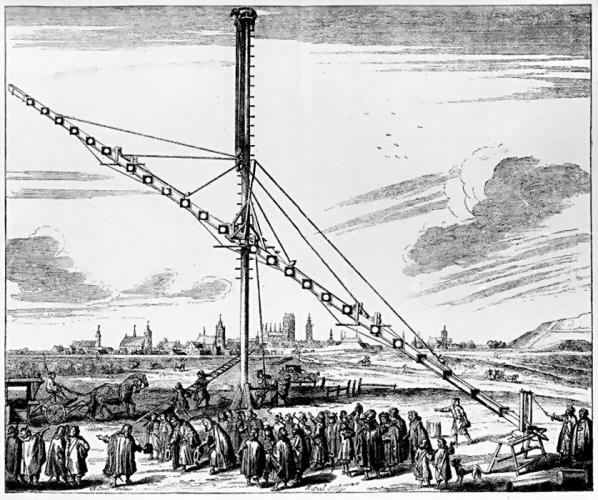
Today we are in a new situation because so much of our perception of the world comes not through extended senses but, in a real way, through new senses. This has been happening over a number of decades; the first wave of this was at the end of the 19th century when there was a cultural shock with the introduction of x-ray images, infra-red and later radio — which didn’t extend existing senses but augmented them.The most recent series of triggers maybe comes from the nano-sciences and synthetic biology — we now perceive phenomena of which we have no daily experience of (eg quantum phenomena). Field emission microsopy or MRI or some of the other new forms of imaging really don’t build on our existing experience — there are discontinuities and dislocations. Another element is of course the hand held device that leads to techniques for ‘augmented reality’ — I have a phone app that I can point at an aeroplane overhead and it tells me what the plane is, where it came from, and where it is going.
Coming to your question about the city — there is clearly a shift in map construction and reading — from the Cartesian map that we have been acculturated to. The ability to toggle between the bird’s eye view and the “street view”, and the ability to view maps that have multiple layers simultaneously are driving artists and others to develop new forms of representation.
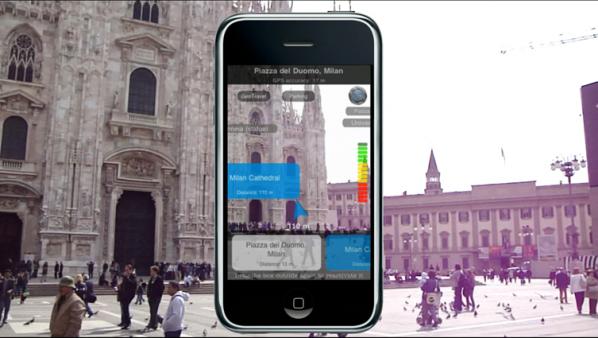
Someone whose work is interesting in this regard is Bryan Connell in San Francisco, he just finished an art science residency at IMéRA in Marseille. He was working on a large urban trail project called GR13 — 300 miles through industrial, urban, sub urban, and wild landscapes (the city had a hell of a time getting right of way through these areas). Bryan is currently working on a web site for the Marseille European City of Culture events, where he’s working on some of these questions of representation. The project involves a collective of ‘artist-walkers’ that I think fits right into this question of performativity.

LB: There’s currently a great deal of interest in the connections between representation, digital technology, and politics, for example the current Hybrid City II conference in Athens. As you’ve pointed out, these often underline the connections between what digital media mean for artists and what they can contribute to citizens — what’s emancipatory about them. What can art offer civil life in this context? Are there any conflicts or contradictions in that relationship?
RM: One pertinent example is the work of Bruno Giorgini, a physicist, and Mariateresa Sartori (visual artist) who work on the “physics of the city.” They were recently in residence in the IMéRA Mediterranean Institute of Advanced Study which hosts artists and scientists in residence who want to work with each other. We now have access to incredible amounts of data on human mobility (pedestrian and various forms of transportation) so it is now possible to study human behaviour quantitatively. Sartori discovered that she could tell many things about a person just through the morphology or topology of their movements through the city. Girogini discovered that people’s movements could be predicted at the 80% level, but 20% of the time he had to introduce what he called ‘social temperature’; in discussions he also referred to this as a ‘free will’ parameter. Barabasi has found similar results analysing cell phone GPS data of individuals. So its interesting to think of the development of cities as 80% predictable and 20% serendipitous. This of course then highlights the role of the arts and culture in making cities part of the cultural imaginary that drives people to make choices. Recently Max Schich here at the University of Texas has analysed very large data bases looking at where prominent people are born and where they die over the last 500 years. Immediately you can see how suddenly certain cities become cultural ‘attractors,’ say the way Berlin or Hong Kong are now. And of course cities are now trying to ‘design’ this into the development of cities. Here in Dallas there has been a huge investment in the ‘arts district’ and in institutions of higher learning in the belief that healthy cities require such investments. See for instance the US National Endowment for the Arts Program; there are many similar programs in Europe.
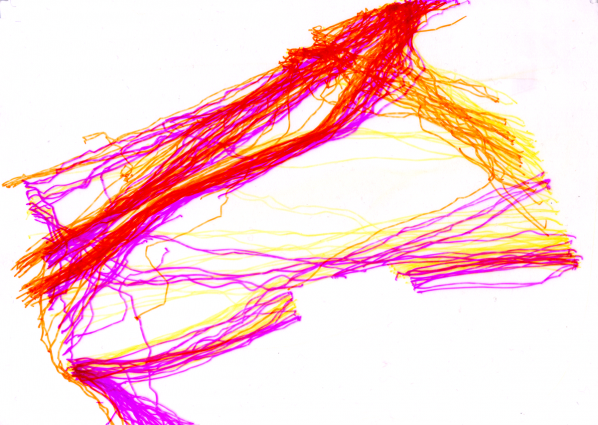
This doesn’t yet address your ’emancipation’ question. One of the things that is happening is that we are becoming a data taking culture (see the recent literature on ‘big data”). The cell phone has transformed every citizen (that has one) into a data taker. Of course much of this data is used by companies for marketing objectives. But many citizen groups are now able to take data for their social objectives. Some of this is captured by the ‘citizen science’ movement ( one example is here). There have been good examples of citizen’s taking data (on pollution, on illegal activities etc.) and then being in a position to challenge ‘authorities’ of various kinds whether scientific, political or economic (see for instance the way citizen groups have mobilised to collect data after man-made disasters such as oil spills, or illegal logging in forests).
A few years ago I wrote an open data manifesto which argued that I would like to advance a new human right and a human obligation:
1. Each of us has the right to the data that has been collected about ourselves and our own environment.
2. Each of must contribute to the knowledge construction by collecting and interpreting data about our own world.
Most scientific data collection is funded by public tax payer funding. The public has a fundamental right to all data collected and funded by public tax money.
LB: How do you imagine an artist’s training will change as these conditions evolve? And a scientist’s — could we foresee any kind of convergence?
RM: One interesting development is a cohort of hybrids, who have one degree in science or engineering and one in art and design ( for example J.F. Lapointe, a researcher at the National Research Council of Canada with degrees in molecular biology and dance) or degrees in Science or engineering and employment in art or design (like myself or Paul Fishwick, a key figure in the field of aesthetic computing). There’s been an emergence of art/science Ph. D. programs that take students from art or design or science or engineering. I suspect this cohort will grow over the coming years.
LB: Mariateresa Sartori, your IMéRA research project with Bruno Giorgini focused on mobility in the city. Can you tell us a little bit about how your work and Dr. Giorgini’s work complemented each other? What kind of evidence did you bring to the table as an artist?
MS: The project I worked on with Bruno Giorgini developed an exploration that began with earlier work in Venice. There I created a series of drawings using a rudimentary, even crude procedure: I traced out the movements of each pedestrian in the Piazza San Marco, drawing their paths with a felt-tipped pen on a transparent sheet placed over the computer monitor. I then faithfully transferred the results onto ordinary large sheets of white paper. The lines thus drawn in different directions created a space, drawing a St. Mark’s Square that is actually not there. As well as the actual physical space, it is also a drawing of our individual and collective manner of relating to space. Each single path determines the route of others, in a continuous and reciprocal game of influences that makes our collective progress.
At IMERA we developed this method for a new environment, a city more ethnically and culturally plural than Venice. Together we set up procedures and tools for collecting data about mobility networks there: nodes, links, chronotopi. These drew on the work of Bruno Giogini’s Laboratorio di Fisica della Città of the University of Bologna. We shot videos focusing on specific behavioural patterns where strategies of shifting, approaching and distancing play a decisive role; and we were also attracted by the places and situations of pedestrian congestion. Using the same technique as in Venice, I translated these into drawings of movement. These again created a space that marks out squares and places which are actually not there, each synthesizing space, time and humanity in a single image.

LB: Is there an emancipatory or governance-related dimension to this work? Degrees of mobility have human rights implications. How does your work as an artist connect with these rights, especially the notion of the right to the city?
MS: The first goal when I work as an artist observing reality is observation, i.e. a way of observing that implies a new attention. The result is always instructive because I do not have particular expectations. After lines have been traced following my process, something always emerges and what emerges can be a useful and indicative element for the emancipatory dimension of the urban condition. I would say that Bruno Giorgini is more involved in that dimension than me, especially in the notion of the right to the city.
LB: There’s a current preoccupation among researchers in a number of fields with the relationship between representation, often engaged with/through technology, and urban life. How has your latest work connected with this relationship?
MS: My way of working with technological instruments such as computers is very particular and limited. I use the computer as a technical tool strongly mediated by the senses, i.e. by human perception. I am very interested in modalities of perception: they are so imperfect, yet sufficiently perfect to make our existence possible.
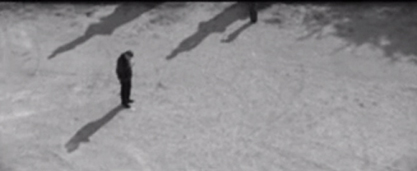
LB: You described the way you work with technological instruments as “particular and limited.” Another way to look at this is that you make the technological system slow down by inserting yourself into the process… and the result is your drawings, which still movement. Might this be one role for art — to insert the human into the machine? Much net art focuses on flows of information, virtual movement, and representing that. While not quite glitch art, do your representations of movement in some sense intentionally put a brake on the machinery?
MS: I find your words enlightening, you describe my way of working better than me….. Actually I insert myself into the technological process…..but this is not a statement of a position against technology.
I can say that what interests me the most (and art’s relation to science is just one instance of this) is the thread of connection between specific cases and general theory, between subjective and objective. Between, on the one hand, the singularity of events and, on the other, general theory. The individual’s experience is singular, unique; but there is always a thread, even if fine, that leads each individual case to a wider generalisation. What interests me is this incessant – indispensable as much as concealed – mental activity that every day leads us to search for generalisations and regulating principles. What interests me is the human tendency to comprehend phenomena, even the most complex, via schematic representation, via a generalisation that leads to the identification of organising principles. I mean “Comprehension” in very wide sense, where emotions and feelings participate too in embracing reality, including reality. Maybe in this sense I put the human in the machine…
There is a discrepancy between how we perceive reality, mediated by our senses, and the truth decreed by science. On a rational level we recognize the truth, but we cannot internalize in a deep way this knowledge; this is beyond our human capabilities. I think that in my artistic research I find myself in this deep discrepancy.
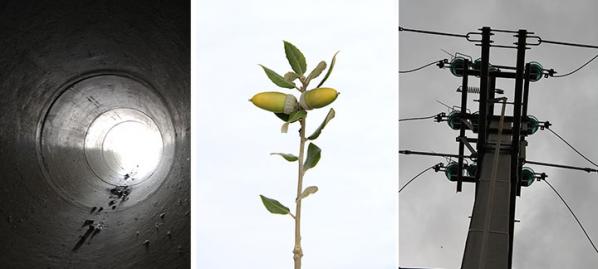
LB: Bryan Connell, your work in Marseille addresses, among other concerns, technology and its relationship to nature. Do you see the urban environment as playing any particular role in that relationship — of having a particular status in our negotiation of it?
Bryan Connell: One of the things that intrigued me about the metropolitan hiking trail in Marseille is the way it plays with our sense of meaning and value in the exploration of contemporary landscapes. Most long distance hiking trails are designed to lead out of urban environments, not into them. We don’t usually think of carrying a field guide that illustrates the taxonomy of fire hydrants, electrical pylons, or urban weeds on an extended city or suburban walk. That kind of engaged, systematic attention is usually reserved for wild natural terrains. From a traditional environmental perspective, the less altered a place is by human technology, the more scientifically interesting, ecologically exemplary, and aesthetically rich it’s going to be. Without undermining the validity of ever-present environmental concerns, the trail functions as an invitation into a more challenging and complex relationship to the emerging para-wilds and novel ecosystems that are arising at the intersection of the natural world and the technological infrastructure of the built environment.
Similarly, the Marseille trail doesn’t really focus on the kinds of urban sites that are traditionally thought of as having significant historic, architectural, or cultural interest. Instead, the trail route incites visitors into an exploration of the everyday environments and working landscapes of the contemporary urban transect – a world of parking lots, freeway overpasses, suburban developments, abandoned railways, and semi-rural wildlands.

Landscape ecologist Earl Ellis argues that to better navigate our way through the current geohistorical epoch, the Anthropocence, we must expand the traditional ecological concept of regional biomes into the parallel notion of “anthromes” – biomes that are complex interconnected melds of human technology and natural systems. In a sense, the GR 2013 Marseille trail is a sketch or system of exploratory paths into what a publically accessible, anthrome based urban ecology observatory might look like.
LB: A similar question is in relation to the image, especially sequential images. What does it mean for our negotiation of the relationship between nature and technology? Between science and art?
BC: We increasingly live in a networked digital metropolis with an image and information density that both mirrors and exceeds the high population densities of the physical metropolis. One topic of particular interest to me is the role these images play in transfiguring the quality of our desire. To what extent do scientific or aesthetic images that increase our ability to find meaning and satisfaction in observing and understanding urban landscape phenomena mitigate our need to physically alter the landscape to conform to an idealized image of what it should or shouldn’t be?
For example, the Marseille metropolitan trail didn’t require much physical alteration of the terrain – it’s a conceptually designated network of pre-existing roads, paths, streets and highways. The trail’s function is not to alter place, but alter the cognitive landscape of trail users so they have a richer sense of place. If you are fascinated by the diversity of ways a para-wild plant population has adapted to a technologically modified environment, do you need to engage in an energy and material intensive re-landscaping of that environment with a palette of conventional horticultural plantings to make it more “beautiful”? In this sense, constructing interpretive images of landscape is more than a way of augmenting a recreational hiking experience, it’s a way of shifting and re-configuring what we think we have to consume and alter to find meaning and vitality in contemporary landscapes.
http://uranus.media.uoa.gr/hc2/
Hybrid City is an international biennial event dedicated to exploring the emergent character of the city and the potential transformative shift of the urban condition, as a result of ongoing developments in information and communication technologies (ICTs) and of their integration in the urban physical context. After the successful homonymous symposium in 2011, the second edition of Hybrid City has grown into a peer reviewed conference, aiming to promote dialogue and knowledge exchange among experts drawn from academia, as well as artists, designers, researchers, advocates, stakeholders and decision makers, actively involved in addressing questions on the nature of the technologically mediated urban activity and experience.
The Hybrid City 2013 events also include an online exhibition and workshops, relevant to the theme
Hybrid City Conference 2013: Subtle rEvolutions will take place on 23-25 of May 2013.
The Hybrid City II events will take place at the central building of the National and Kapodistrian University of Athens.
This document was edited with the instant web content composer. Use the online HTML editor tools to convert the documents for your website.
Featured image: Still from Me and Mrs Sloan (Susan Sloan (2007). Motion-captured animation of artist’s mother.
Susan Sloan’s exhibition of motion captured portraits on The Wall at The Photographers Gallery raises issues in terms of data object relations and computer animation – or ‘animatography’.
In critiquing the work by Susan Sloan, currently on show on The Wall, what emerges is the artist’s concern with the essential qualities of the data space that she is utilising. What has become apparent is the distinct new medium of animatography, as used in virtual reality art works like Sloan’s, as well as in the more ubiquitous moving image; a language which is not composed uniquely by the author/animator, but also by the apparatuses of computing and software development which are then engaged with by artists and other individuals, “they [photographs] are produced, reproduced, and distributed by apparatuses, and technicians design these apparatuses. Technicians are people who apply scientific statements to the environment.” [1] In this way, a piece of proprietary software like SoftImage, can be seen as an apparatus much like a camera or an easel.
In answer to the Photographers Gallery’s questioning of the impact the digital is having, I would argue that the critical and theoretical discussion of computer animation use in virtual art works should focus on the creative exploration of data object relations. I am also suggesting that the term animatography be applied when talking about the medium of computer animation, and the following discussion focuses on the development of an awareness of how this language is utilised in art in virtual space.
The medium of animatography can be explored as an essentially synthetic medium which extends the languages of animation into one of data object descriptions; the use of data to describe virtual objects, and the complexity of these descriptions. Sloan’s work very much explores the nature of applying data to ‘objects’ or rather, as it means in psychoanalytic terms, subjects. The work is composed of complex object descriptions, comprising 3-D modelling techniques as well as motion capture data.
First it is necessary to look at data object relations in terms of psychoanalytic theory, then its applicability to animatography. Susan Sloan’s work, highly explorative of this as it is, is looked at to further elucidate the relationship between data, psychoanalytic theory and animatography.
To understand this approach it is first necessary to outline a theory of object relations as explored by Peter Fuller in relation to art works. Fuller applied D.W.Winnicott’s major psychoanalytic concept of the ‘potential space’ [2] and found that he could relate this theory to his study of aesthetics, and it has informed the development of a theory of animatography, which is based on our relationship with ‘data objects’, in aesthetic and cultural terms.
Winnicottís theory describes a baby’s gradual development and awareness of herself as a ‘separate autonomous human being’ [3] in relation to, at first, her mother. While up until that point she has felt at one with her mother, several months after birth, at a key moment, this recognition of autonomy starts to occur. Fuller writes, “This process of discovery seems to be a vital period of human growth. During it, the baby, necessarily posits the idea of a ëpotential space.” [4] He quotes Winnicott’s definition of potential space as: “the hypothetical area that exists (but cannot exist) between the baby and the object (mother or part of mother) during the phase of the repudiation of the object as not me, that is at the end of being merged in with the object.” [5]Fuller then points out that “Much in Winnicott’s view, depended on this ‘potential space’ between the subjective object and the object objectively perceived, between me-extensions and the not-me.” [6]
Potential space, Fuller explains, is important to creativity and to understanding aesthetic experience. The ‘location of cultural experience’ is derived from the ‘potential space’ where ” – if he has sufficient trust in his environment – the individual can explore the interplay between himself and the world, not as mere fantasy, but as cultural products which can be seen and enjoyed by others.” [7]
Similarly the cultural products of computer animation and therefore the aesthetics of animatography can be seen to derive from a relationship to the potential space, as transitional objects of meaning and value generated through a type of work and/or play. For Winnicott, “play is the paradigm of cultural activity” [8] and “cultural activities are those in which the experiences of the potential space are still operative.” [9] If we take Winnicott’s and Fuller’s theories, the potential space exists for artists, animators and a participating audience in which a play of separation; where a perception of what is me and what is ‘not-me’, takes place. There is no essential difference here between traditional media and animatography, apart from the specific differences of the nature of data itself, and therefore how we relate to data object descriptions.
If we add to this theory of ‘potential space’ with feminist psychoanalytic theory, which, in contrast to a generally masculine approach sees positivity in closer connectedness: “Chodorow herself suggests that care and socialisation of girls by women produces attributes which could (and should) be regarded positively; a personality founded on relations and connection, with flexible rather than rigid boundaries, and with a comparatively secure sense of the non-hierarchical nature of gender difference.” [10] We can see Sloan’s work as a carefully constructed interplay between artist and subject. Also, what does it mean to be described by data, which has automation at its heart, and yet requires a lot of skill to achieve this level of detail?
In virtual environments, the avatar is a key aspect for enabling a realisation of the ‘world’ to take place through human-computer interaction. In the works currently on show, Sloan looks intensely at the animated portrait, which inevitably relates to the condition of the avatar, while raising questions of perception to do with notions of reality and authenticity. Portrayed through animatography, the data object of the portrait model is related to as a me-extension, as well as sometimes being felt to be not-me, but a representative of the self, in terms of the freedom of self portrayal in this genre. In this sense, Sloan’s work suggests avatars ‘which really look like you’, through which the complex psychological reaction of what is me and not-me can be apprehended.
As such animatography could be said to have a physicality, in terms of the data it is composed of. Projecting the imagination into a notional space, the artist can at the same time make that space pragmatic in symbolic terms. A fantasy, and yet a data driven reality. This paradox between perceiving the physicality of data and the perception of the animatographic illusion as simply a fantasy lies at the heart of this relationship.
Susan Sloan’s Me and Mrs Sloan (2007), explores data object relations in the form of a motion captured portrait of her mother synthesized with motion captured movement by herself. It is a work about the potential space itself. In this instance, the artist has modelled the head and upper torso of her mother, in 3-D animation software, and then animated the head and shoulders, based on subtle motion captured material of herself. In this way, the data object is her mother combined with herself in terms of the motion captured material. It is Sloan’s work, and therefore the dialogue with what is ‘not-me’ is a fascinating one. The motion captured material is also ‘not-my-mother’, and instead it is a record of Sloan’s slight movements. In terms of locating ‘cultural experience’ (Fuller, 1980) this is a study of whether and how the potential space exists, when working with animatography. What is isolated or exposed, is that we relate to the ‘data object’ in the form of Sloan’s mother, as if the essence of potentiality in the relationship is somehow captured, in a way that explores what it means to relate to data that is ‘all-there-is’. This helps to establish that there is a cultural experience in the work, by the subject of the work itself.
The work explores synthesis in data terms, the portrait model with the motion captured movement used to animate it. In this sense identity is blurred artificially, and a synthetic effect is created, yielding a potential space in animatographic terms. In this work a synthetic identity, in this case between mother and daughter, becomes possible, which is like an advanced form of the avatar in multi-user platforms.
The concept of ‘potential space’ can be used to understand the nature and significance of data object relations in animatography, the me-extensions and the not-me, through programming a computer or manipulating a computer program to make animation is what this work points to in technical terms.
Animation is principally iconic, which means that there is more me-ness in its structure and execution than the traditional film image, which is partly composed of the indexical. [11]It can be argued that the engagement animatographers have with the portrayal of data object relations is precisely what identifies the need for animatography as a separate discipline, one which can culturally embody the unavoidable relationship we now all have with data objects in a more ubiquitous sense.
Data object relations in terms of Sloan’s work, has been considered in relation to psychoanalytic theory and its applicability to animatography. Through analysing a preoccupation with object relations, and specifically ‘the potential space’ as found in Winnicott’s theory, evidence of the potential space is found to exist as subject matter within Susan Sloan’s work. This is potentially an important aspect in critiquing art which explores subtle synthesis as an aspect of data object relations.
Dr Stephen Bell and Susan Sloan at the NCCA (National Centre for Computer Animation) in Bournemouth, United Kingdom
An interview with Katrina Sluis, Digital Curator at the Photographers’ Gallery By Marc Garrett
http://www.furtherfield.org/features/interviews/interview-katrina-sluis-digital-curator-photographers-gallery
Featured image: “Born in 1987: The Animated GIF” from the site’s page.
Marc Garrett interviews Katrina Sluis, the new curator of the Digital Programme at The Photographers’ Gallery, London. We discuss about the gallery’s recent show Born in 1987: The Animated GIF and what kind of digital exhibitions and projects we can expect from the gallery in the Future.
An edited selection shown on the London Photographers’ Gallery’s new digital wall, during the final weeks of the show. http://thephotographersgallery.org.uk/the-wall-2
The exhibition microsite. An open conversation where anyone can join in and contribute their own GIFs. http://joyofgif.tumblr.com/
Marc garrett: You have joined The Photographers’ Gallery and as part of the new digital programme launched the exhibition “Born in 1987: The Animated GIF”. Could you tell us about this project?
Katrina Sluis: The digital programme presents projects both online and offline, which respond to recent dramatic shifts in the digital image as it becomes increasingly screen-based and networked. As part of this new programme we have launched ‘The Wall’ – a permanent exhibition space on the ground floor of the Gallery, visible both to visitors and passersby on Ramillies street. The Wall itself is a 2.7 x 3m Sharp video wall which we installed after considering a number of different technologies. We were conscious not to use digital projection as it would locate the project within traditions of cinema and video art, and we wanted the screens to respond to the reception and distribution of images within wider visual culture.
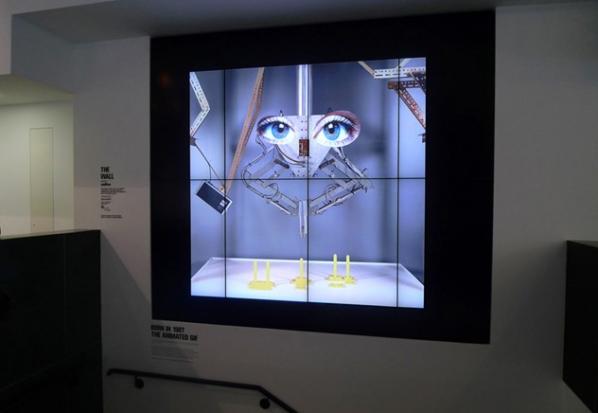
For the opening show, we decided to focus on the animated gif for a number of reasons. Firstly, the gif is a uniquely screen-based image format, in which the specific characteristics and limitations of the image file are inherent to the form, in contrast to the other kinds of images the gallery might show which might adopt digital techniques but result in traditional print-based photographic work destined for the gallery space.
I also wanted to disrupt certain expectations about the screens – the fetishisation of resolution and image quality, and what kinds of photographs The Wall’s programme might seek to address. The animated gif in this sense is very interesting – it is one of the first image file formats native to the web, and although it is 25 years old this year it has been undergoing a resurgence on platforms such as Tumblr. In a commissioned essay for the show, Daniel Rubinstein speculates that current resurgence of the gif “is not only part of the nostalgic turn towards the blurred, the unsharp and the faded but it is also a marker of a moment when the history of the network becomes the material from which the digital image draws its living energy.”[1] Frequently authorless and contextless, the gif image works on a different economy in which its value is based not on its uniqueness and scarcity (as in certain forms of art) but its circulation and proliferation. Although there have been significant practitioners of the gif form, it is a format which ultimately resists canonization. And, in the context of a photography gallery, it opens up other debates concerning medium specificity and the ‘post-photographic’.
In approaching the exhibition, I was keen to ask a diverse range of photographers, writers, organizations and other practitioners to contribute a gif for the show. In keeping with the unmonumental nature of the form, I asked contributors to respond within a short timeframe of 7 days. For many contributors, this was the first time they had made a gif; but other contributors already had large followings on Tumblr and some were established net artists. This opening show and associated Tumblr site (http://joyofgif.tumblr.com) became a starting proposition for the project in order to then open up The Wall to gif contributions from the wider public. We will continue to update The Wall with public responses on a daily basis until the final day of the show on 10th July.
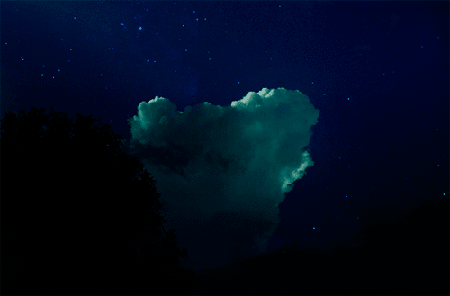
MG: At first, some may assume that the first part of the exhibition title ‘Born in 1987’, refers to the fact that today so many young people using computers these days were born in 1987. Yet, the GIF format, short for ‘Graphics Interchange Format’, was introduced to the world of computers by CompuServe in 1987. Was the title of the show deliberately playing with both notions?
KS: I like this idea! The title does self consciously play with the way in which the digital is valorised for its endless ‘newness’ and novelty but yet has this long and frequently overlooked history of creative experimentation. You can also see this reflected in the recent hype around the work of Kevin Burg and Jamie Beck who have (problematically and entrepreneurially) re-branded the gif as the ‘cinemagraph’.
MG: Do you consider this project to be net art, if so, how does it relate to other forms of net art?
KS: The project (and The Wall’s programming) does pose certain problems as it seeks to relocate certain forms of online practice(s) into the space of the art museum. At the same time, the project exists in an online context with its own very different life on Tumbr, where the work circulates in a very different context with a very different audience. I think there are many interesting opportunities which emerge from this intersection of the institutional frame of the museum (with its associated issues of cultural and curatorial authority and the legacy of aesthetic modernism) and the values and politics which inform certain kinds of networked arts practices.
But I also think the project also needs to be understood in the specific context of The Photographers’ Gallery, its history and audience. Whilst the project shares the concerns of net art by raising questions concerning authenticity, authorship and ‘the social’, it is also motivated by the need to rethink familiar notions of photography and temporality, indexicality and the economy of the image – concerns which presently haunt the field of photography theory.
![Kennard Phillipps. GIF image by Peter Kennard and Cat Phillipps. Born in 1987: The Animated GIF. The Photographers' Gallery 2012 [2]](http://www.furtherfield.org/wp-content/uploads/2012/07/fuck-the-markets-latest1.gif)
![Rad Racer glitch 3. GIF image by tracekaiser. Born in 1987: The Animated GIF. The Photographers' Gallery. 2012 [3]](http://www.furtherfield.org/wp-content/uploads/2012/07/tumblr_m5tqfl62wl1qew2moo1_400.gif)
MG: In what way do you see this form of creativity relating to others who may not be so well versed with net art culture, or digital networked practices?
KS: The Wall presents an opportunity for the Gallery to collaborate with diverse communities who can bring their distinct expertise and experiences to the programme, and the net art community has much to offer in this respect. For this reason, we aim to develop The Wall’s future programme through the framework of ‘collaborative research’, in which our audience, along with the organizations we partner with, are potential co-researchers. The co-researcher model developed as an approach to research democracy in the Social Sciences, particularly in the approach of Action Research in the NHS but in a more relevant cultural example was used extensively in the Tate Encounters: Britishness and Visual Culture research project. Co-research recognises both the collaborative and collective nature of meaning construction, through a process which attempts to trace and reveal the complex manufacture of meaning.
At the same time, there is still another related project to be done in highlighting and responding to digital projects whose life is online – this is of course something I admire Furtherfield for doing so brilliantly. On a smaller scale and with a more narrow focus, we hope to launch a blog which will draw attention to online work which relate to photography as it becomes polluted, valorized, hybridized and networked.
![GIF image by Paul Flannery. Born in 1987: The Animated GIF. The Photographers' Gallery. 2012 [4]](http://www.furtherfield.org/wp-content/uploads/2012/07/tumblr_m442xish4q1rvlji4o1_500b_0.gif)
MG: Some, may view this this exhibition as relating to Internet Folk Art. There is an interesting article by Kenneth Goldsmith[1] where he discusses the digital theorist Rick Prelinger’s claim “that archiving is the new folk art, something that is widely practiced and has unconsciously become integrated into a great many people’s lives, potentially transforming a necessity into a work of art.”
Now, this is not directly relating to the show itself, but it resonates something regarding the inclusiveness of the show. So, in respect of it ‘possibly’ possessing aspects of Folk Art, what connections do you see as relevant or not, and what does it mean to you?
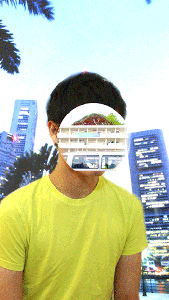
KS: By focusing on the gif the show does problematise the distinction between artist and audience, in which participation, openness and the ‘crafting’ of the image becomes key. However I have reservations about the use of the term Internet folk art, which could be construed as imposing a certain modernist logic on the discussion, burdening it with an analogue modeling of high and low culture. The research approach has been adopted precisely to avoid the trap of binary nominalism, and to problematise the tendency to shoe horn internet practices into the language of cultural studies and aesthetics.
MG: The Photographers’ Gallery was the first independent gallery in Britain devoted to photography and has been going since the 70s. It is the UK’s primary venue for photography and has been dedicated in establishing photography as an essential medium, representing its practice in culture and society. It seems that The Photographers’ Gallery is going through another transition. You have already mentioned how hybridized and networked the nature of future projects will be. So what kind of exhibitions and projects can we expect in the future?
KS: Because digital technology is not in itself a new photographic medium, but essentially a hybrid and converged set of technological practices, it raises many interesting problems, both theoretical and practical for a Gallery focused on photography. To the computer, the photograph is indistinguishable from the other binary blobs of data we used to call books, films and songs. The crisis of digitization and medium specificity now extends to the domain of the camera – Digital SLRs are coveted for their ability to shoot high quality digital video, and we turn to our mobile phones when we want to take snapshots. This is a very rich context for the programme to explore, and ideally the future projects will respond to the technical, creative and cultural languages of photography as produced by computer engineers, web developers, photographers, artists, networked communities, social scientists and other practitioners.
Our next show on The Wall (opening 13th July) features the practice based research of Susan Sloan into portraiture using motion capture and 3D animation techniques widely used in entertainment, medicine and the military. Her motion studies refer to the traditions and conventions of portraiture and the changing role of the camera as a recording device. At the same time, her work raises questions concerning the convergence of painting, animation, film and photography in the digital realm.
The future digital programme which will occupy different spaces and address various photographic practices including augmented reality, social media, electronic publishing, interactive media, mobile computing and synthetic imaging.
The Joy of GIF – the London Photographers’ Gallery’s new digital wall. Article by Wendy McMurdo.
http://www.foam.org/foam-blog/2012/may/photographers-gallery
‘Living’ is the result of a six month residency at the V&A by Christian Kerrigan – from January to June 2010 – and it is part of The 200 Year Continuum. The 200 Year Continuum is the title of a project by the same artist that explores the relationship between nature and technology. Interestingly ‘Living’ was exhibited in the same space where it was created: in the digital studio of the V&A. This was a small room with dim light and crowded with rarities. It felt like one was penetrating the secretive and magical space of experimentation of some sort of mad professor.

Once in the space my gaze wandered around a series of oddities. On the right, a table full of raw materials; in the middle of the room, a fish tank with algae floating in high pH waters; on a wall, a real time video projection showing the evolution of the algae; on a different wall, a slide projection showing some drawings; in some shelves, notebooks with notes by the artist; above the sink, chemical products piled up on a shelf; and on each and every window a semi-transparent drawing. No explanations, no titles, nothing. It’s you and the objects. Luckily Christian Kerrigan was always about, meeting visitors and discussing the work. We started looking at the materials on the table. Christian told us those were unprocessed rocks and crystals that he used as the starting point for his drawings. He scanned pieces of amber, moss, fiber glass, volcanic rock or resin and produced a model using 3D software. Then he manipulated that model to create his drawings and printed them on semitransparent paper. He eventually placed them on the windows of the space. This routine allowed him to explore the different stages of a process that makes real matter and virtual space intermingled. It is a practice that explores where the process of creation begins, and what it does to reality. ”The drawings, he tells us, become extensions of the physical material which I started with.” Although we have become accustomed to discuss the hybridity of our nature-culture, the way Christian carefully interwove materialities and virtualities was very evocative. The fact that the drawings were placed on the windows gave yet another layer of complexity to the mixture. The colours of the printings morphed natural light into a hybrid light turning the atmosphere of the room into a creative and ongoing process.
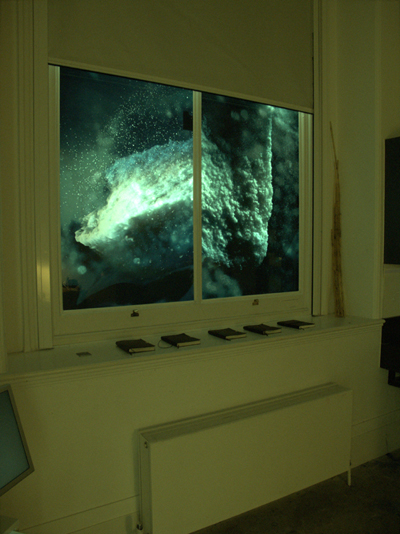
Next I wondered about that mysterious fish tank in the middle of the room where algae lived (and died) in high pH waters: Encased Nature. Apparently the algae reacted to the elevated pH creating a protective coat that eventually killed them. At the bottom of the tank: a graveyard of coated dead algae showed the consequences. I instantly loved the idea. Again an experiment about the hybridity of natural and controlled habitats. I thought it was a particularly dystopic illustration of the environment we inhabit where control works on the conditions of the environment, dictating the way reality unfolds. This is an emerging tendency in our most-discussed societies of control, what has come to be called soft control. And we could take it even further, and see it as a great illustration of today’s climate of fear. In such a habitat, the threat has become virtual and all-pervasive, it has become poisonous in itself, just like high pH. The nightmare of security measures that this artificially produced environment justifies links quite well to the ‘lethal-protective’ coat. What this allegory leaves out, though, is the power of imagination! The capacity of conditions to be turned around, the potential for intervention and deviation from the pre-programmed chain of (re)actions. The idea of projecting a live video recording on the wall was to intensify the experience and highlight the importance of mediation. As Christian argued, we are now more used to experience nature through a lens than to experience its presence. However, the quality of the footage seemed to work against the intentions of the artist and rather than intensifying the experience of that enclosed nature, it tended to obscure it. The particular texture that the webcam gave to the recordings turned that hybrid habitat almost into an abstract movie. On a different corner there was another video projection made out of a series of drawings. Interestingly they had been created using a ‘living technology’ and recorded at a nano-scale. For Living Drawing, the artist had collaborated with Martin Hanczyc from the Department of Physics and Chemistry at the University of Southern Denmark. They had manipulated some protocells that inhabited chemical gradients and reacted to ultraviolet light. When UV light was applied to the fiberglass where these protocells ‘lived’ their motion left traces of colour that were recorded. This technique, although still in its early stages, allowed the artist to ”explore the spontaneous event of drawing by using organic systems”, he told us. Kerrigan’s rather cryptic exhibition proved to be an inspiring and very personal exploration of the blurring between nature and culture in its absolute physicality. Paying particular attention to the materiality of the creative process, from the composition of the materials used, to the chemistry of the drawing process or to the laws of electromagnetism that inform light in its interaction with his work, his methodologies show a passion for unfolding reality in its many scales. His work is that of someone who’s starting to explore rather than someone who’s making an assertion; it is tentative rather than conclusive, it is interesting for its questions rather than its answers. However, even if sometimes vague, it is at points pleasingly dark and sometimes inspiringly intense.